#but mostly as a meta-metaphore
Text

I wrote about my dearest Cy and (approximately) how he came to be.

Read it here.
#thoth.txt#black artist#writing#creative writing#origin story#Before Compleation#religious imagery#but mostly as a meta-metaphore#I love my goop man#magic the gathering#i only have vague knowledge of MTG lore#phyrexian#tin cans only bro
9 notes
·
View notes
Text
The Magiciatron
A couple of posts came across my dash recently in quick succession about Crowley and Aziraphale’s costuming, and boy howdy did they get me Thinking™. The details of those posts are not super relevant, but they did inspire this one and were quite insightful, so I’d recommend giving them a read anyway, as well as the several other posts I have linked throughout where ideas were taken. Please do give those a read/reblog as well!
And then take a look at this post I saw:

“You’re not trying to trick me, are you?”
Now kindly consider the fact that Crowley is beside Muriel’s left shoulder (like an angel) and the Metatron is on Aziraphale’s right (like a demon). And notice, like I did, that the lapels on his coat are some of the lowest we’ve seen. Which, for an angel-who-isn’t-Aziraphale, and you know, the literal fucking voice of God, is pretty fucking weird. But I digress.
Because what’s important here is that you’re reminded, like I was, how weird it is that the Metatron is wearing so much black.
Surely the most important angel we’ve ever met-- who up to this point, has only ever been depicted as a brilliantly glowing white head, and is (stage blocking-wise, literally) above inhabiting the typical corporations that other angels have, even while in heaven-- surely he would be sporting the cleanest, purest, whitest clothes imaginable, right?
But... he isn’t. He’s not wearing grey or beige like any of the other angels, or even white like Muriel’s constable uniform, he’s wearing black. That’s weird! Angels don’t wear black! Oh... well except when they’re magicians, of course:

(X, X)
But even in his magician costumes, Aziraphale retains many elements of his angelic nature: the upward-pointed lapels; the white cuffs poking out of his sleeves; the floppy bow ties; the single-button or open jacket revealing the soft gold and velvet vests. This is merely a flashy costume! Don’t worry folks, he’s still the same, good old angel underneath!
The Metatron, on the other hand, does not have any of these angelic indicators. Underneath his magician’s coat-- which is big and loose, falls closed in front of him in a way that obscures his suit, and has extremely downward-pointing lapels-- he wears a dark tie, and a very normal-looking, white, pinstripe shirt. No angelic tartan to be seen, either. It’s a very understated, business-minded look compared to Aziraphale’s flashy stage getups. Also worth noting imo is that in many scenes, the Metatron has his hands in his pockets, which obscures his form even more.
Now this might be indicative of something more, some larger scheme we haven’t deduced yet, but by itself it’s a brilliant move by the costuming department, adding yet another perfectly conniving layer to the Metatron’s manipulations:
Dress him in the magician’s coat and send him on stage, where his tricks are hidden in plain sight...
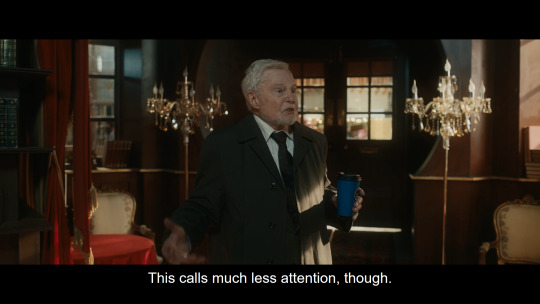
Engage the audience to participate in a dramatic reveal...
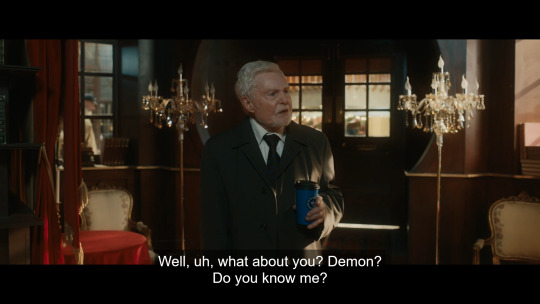
Reassure his volunteer that his props are completely normal by offering them up for inspection...
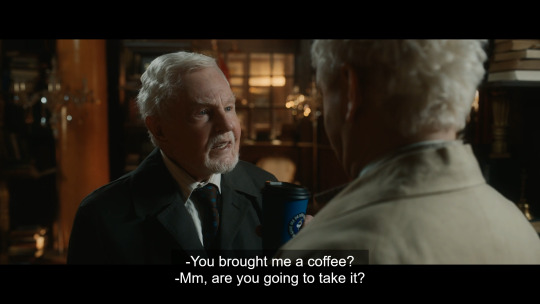
Have the assistant do all the flashy presentation for him...
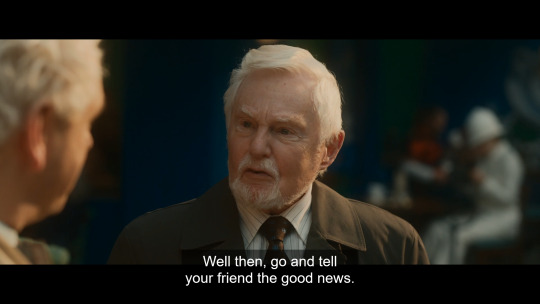
So that while the audience is distracted, they fail to notice...
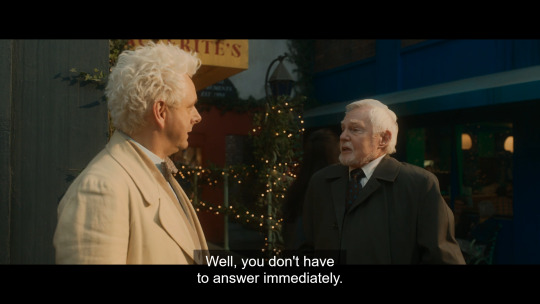
... that a swap has been made...

And then the curtain falls. Show over. Audience fooled. Job well done.
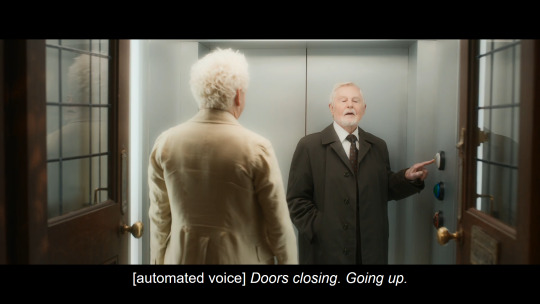
The End.
#good omens#good omens meta#good omens analysis#good omens season 2#good omens spoilers#gomens#gomens meta#aziraphale#the metatron#by me#hes got such a smug look on his face as aziraphale steps into the elevator#he performed his trick flawlessly#be advised the stand-ins for audience and volunteer and assistant are mutable in this metaphor#the only constant is that the metatron is the magician#ok i think thats it SHOOTING THIS OUT INTO THE ETHER NOW#this line of thinking was MOSTLY inspired by the crowley post#and his turtleneck being his 'spy outfit'#which got me thinking about if his white server uniform at warlocks birthday counted as a spy outfit#bc it has lapels (pointed up) whereas no other servers do#which then got me thinking about how hes wearing white and aziraphale black#and then i saw that first post and remembered that metatron ALSO wears black#and then i thought about it for four days then posted this#this is not supporting evidence for coffee theory!!!!!!!#this is a doyalist analysis of costuming and what metatrons role is in that scene#ty for reading
250 notes
·
View notes
Text
The more I think about it the more I’m like I do not want this authority movie to happen actually
#like they’re supposedly going to be in Superman as a metaphor for anti hero culture and I’m like…#that’s interesting and worth talking abt. but like. first of all use the elite that’s what they’re there for.#2nd of all I do not trust them to do it well#I’ve just been burned too many times now whenever I see a comic I like getting adapted I just get sad#mostly bc I really hate the culture that surrounds these films#the good news is i was equally worried abt moon knight and that had no cultural impact after a few months so we stay winning#especially if they replace Jenny w Manchester like…BE SERIOUS!!!#she is the og she is everything.#and I say this as a huge Manchester stan he literally doesn’t work as well without her existing within the meta#also I like him bc I have problems. he should not be in the authority#warlock wartalks
4 notes
·
View notes
Text
Saw this post a while back about how Camilo does not change his voice in the movie and it occurred to me that this could mean something metaphorically.
It's all very well to look like someone. You look at them and copy what you see. But to use someone else's voice, to speak how they speak… it takes a deeper kind of understanding. You need to look below the surface and that's harder to do. The whole movie was about how none of the characters were what they appeared to be on the surface – Isabela wasn't a perfect princess, Luisa wasn't okay – and their true feelings were revealed through singing – through their voice. Appearances are sort of contrasted with voices in Encanto, so the fact that Camilo is always doing the former and not the latter… well. It says something about him.
He doesn't want to look below the surface. He takes what people tell him about Bruno, for instance, at face value, unlike Mirabel who tries to dig (unless her personal feelings get in the way). You know how it is, la familia Madrigal has to be the perfect family and the Encanto the perfect place that Abuela and the villagers need them to be. Camilo and the rest of the family are all aware that they're notperfect, but they lie to themselves and others to keep up the facade rather than admitting even a moment of vulnerability.
But Camilo is very aware that he decieves everyone including himself on a daily basis, because he's a) a shapeshifter and b) the Face, so he's on the frontlines carrying the lie. And yet he doesn't want to stop. It's his role in the family and that's one of the few things about himself he knows for certain, so he'll do it and he'll do it well. He crafts a careful image and sticks to it like gum, not allowing himself to consider other possibilities.
The point is Camilo can't do other people's voices because he doesn't look past people's appearances. He can't afford to.
(Also Jared Bush has said that Camilo can change his voice and adds that "a good vocal impression can take a lot of practice" which kind of adds to my point?)
#camilo madrigal#encanto#encanto meta#thinking about the gifts and The Metaphor#and yeah#mostly thinking about camilo#and the warm family#The Metaphor is what i like about encanto#the depth it lends the movie#you can really taste the love in it#feel the thought put into it#forget the rent#this movie lives in my brain for free
9 notes
·
View notes
Text
man i need to make a compilation post with links to other sdmi posts of mine that have been straight up eaten by tumblr's garbage blog search function lmao
#whosebaby talks#blog policy#SDMItag#thankfully my sdmi meta stuff has been mostly compressed into the last few months' archive#but that's not going to be the case forever or for everything; even for *me* to be able to find them again#when i remember which ones i wrote! and recognize the snippets at the beginning that are all you see in the thumbnail!#other people will not have the first clue to even look; and i post things because i want people to be able to see them!#so yeah i think i'm gonna try to start doing that for various fandoms i post about lmao#starting with sdmi. maybe i'll make a directory page for the different compilation posts too or something#this brought to you by 'had to dig back through my archive for that one post about the talking animals in sdmi'#'being an obvious and really nasty metaphor for disabled people; to reference in another meta post'#Like That's Not a Side Thought It is Really Important Actually#ableism mention cw
1 note
·
View note
Text
Red & Yellow Can Hurt a Fellow:
Color Symbolism in 1941 (Part 1)
(Plus Bonus Sundry 1941 Observations)
"Nazi Zombie Flesheaters" is such an interesting title, isn't it? You don't need to say flesheaters if you've already got zombie: it's redundant. It's like the title was chosen by someone unfamiliar with very basic zombie tropes. Also fwiw "Nazi zombie" is an anachronism: zombies did not exist in the popular consciousness before George Romero's Night of the Living Dead in 1968. I feel like maybe an angel titled this minisode. There is evidence both that the Metatron fucks with the story and that the flashbacks are Aziraphale's memories, so my guess is it's one of them.
***
In "The Colors of Crowley" I make an effort to evidence that crimson red is both the the color that symbolizes Crowley to Crowley and also the color that symbolizes passionate romantic love.
In light of that, here is this tiny beautiful moment:

As they did to each other in 1793, Crowley is sending a message here to Aziraphale with his clothes, so let us dwell on it.
Crowley's tie has Aziraphale's colors on it--white and blue-- in a design that connects two points (through a larger, dark point between them), one above and one below.

And Crowley opens his jacket with a flourish and shows Aziraphale the tie.

So first we we get this beautiful gesture of opening a covering and exposing a hidden, brighter, truer self beneath it, along with the metaphorical implications of exposing the heart and the guts, the snake showing its vulnerable red belly. Then the tie says, I like you. I'm wearing your colors. I want to be connected to you. And Crowley doesn't just display that message by opening his jacket, he then calls attention to it by straightening the tie.
Aziraphale gives no outward sign he has received this message. But.

There is so much red in this bookshop tonight.
The bookshop structure is brown and tan, with bright yellow in the back rooms (just as Aziraphale always has fear in the back rooms of his mind). But in this flashback there's a red carpet on the steps in front of the door, a red carpet on the floor in front of that, a display of red books on the circular tiered stand, a pile of red books in the corner, more red books on the windowsill behind Crowley's head, and the red velvet chair that Crowley's sitting on.
Here's the other side of that room, i.e., what Crowley is facing:

The walls of the bookshop are, again, brown and tan, but there's a red rug, red brocade on the front panel of the cashier's table, two red-upholstered chairs, and a red-stained chest of drawers Aziraphale is mostly blocking, plus another red thing in the right corner behind the stepladder that I can't even identify but that looks like the same velvet as the chairs. That's a determined effort to cram in as much red into a brown space as possible without actually taking a paintbrush to anything.
There are other metas showing how Aziraphale takes pains to make the bookshop into a welcoming place for Crowley [link if I find them again]. Just as likely imo his love of red and gold in soft furnishings is to remind himself of Crowley because they don't get to see each other very often.
But the books Aziraphale would be constantly rearranging, and buying more of, and possibly even occasionally selling when it can't be avoided; and bibliophiles do not generally organize their books by color. I therefore suggest two things are happening simultaneously here: on the Doylean (authorial) level, the set dressers are using the red notes in these backgrounds to symbolize the passionate romantic love Aziraphale has just realized he feels for Crowley; on the Watsonian (intra-story narrator) level, Aziraphale's feelings are "coloring" his memories.
This red as symbolic of Aziraphale's feelings for Crowley is not subtle. It starts immediately after his epiphany about those feelings--I mean literal sparks fly--

--and it does. not. let. up.

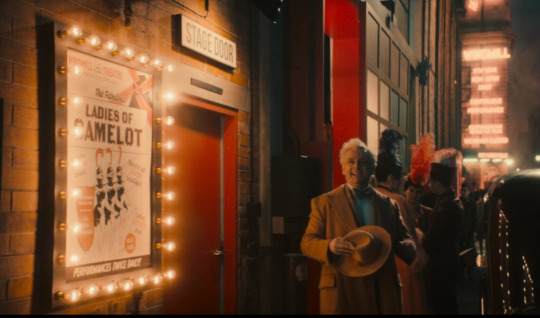






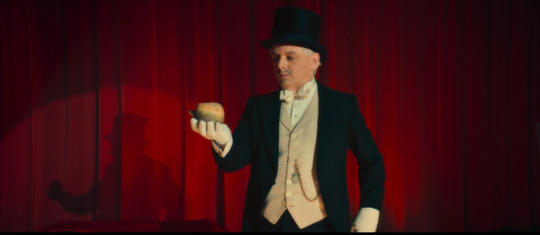


Note the other colors in the (brick red) dressing room besides red: blue, white, and off-white, Aziraphale's colors. There are even white and off-white feathers, indicating these are the angel's feelings we're being shown.

Brief digression. I've listened to this line several times now and for the life of me can't hear the final -s. I suspect Crowley may in fact say "Chalk up a win for the side of the angel," i.e., Aziraphale, which definitely makes Aziraphale's reaction of giddy delight track well, but I don't have a decent pair of headphones, so if someone would be willing to verify whether I've caught a Moment or just have romance on the brain, I'd be very grateful. [Update: I've got one confirmation so far that Crowley says "angels."]
Anyway. Note the splashes of blue and off-white surrounding Crowley, indicating all this red (he's sitting on a red velvet chaise btw) continues to be linked to Aziraphale's feelings for him. This whole narrative is drenched in Aziraphale's passionate romantic love.
Until this moment:

Now something really interesting happens. For the first time in the scene (I went back and checked), a bright spot of canary yellow suddenly becomes visible in the frame.
It's a jar of ostrich feathers, dyed bright yellow, on one of the dressing tables. How do we know it's meant to represent fear?
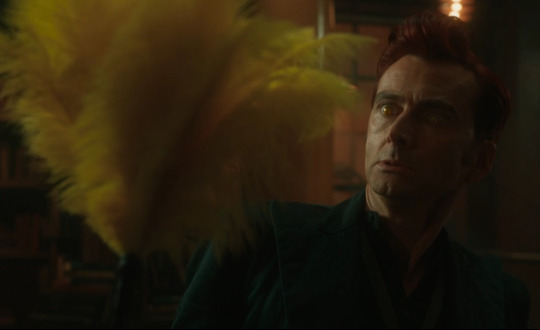
Because it already has done.
And remember how yellow is specifically fear of the head offices?

Look who shows up.
Now suddenly the camera shoots Aziraphale from a different angle, and yellow appears in the frame here, too--more fear.

The yellow feathers remain visible between Aziraphale and Furfur for the remainder of the scene.
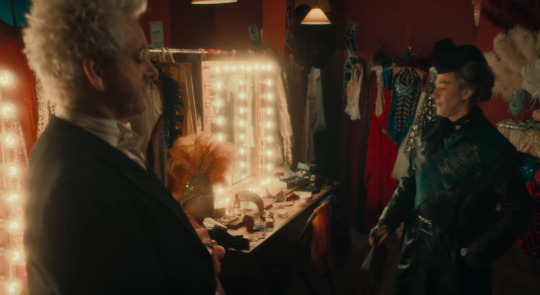
So that's one gif and 18 stills I've shown you thus far in this essay about how the use of red in and yellow in this minisode is consistent with the use of red and yellow throughout Show Omens and is being used in a symbolically meaningful way, right? I mean they come down pretty hard on it.
So it's very interesting, in terms of colors, how the minisode ends.
Which I will talk about in Part 2!
#good omens#good omens 2#good omens 1941#good omens meta#good omens color symbolism 1941#furfur#ineffable husbands#aziracrow
267 notes
·
View notes
Text
Its been a while now, and I've slept on it, but I'm still reeling from episode 7 of Dead Boy Detectives. Even if I can find critique in other episodes - somewhat clunky dialogue at times, a lot of exposition, the teenage drama which can sometimes get tiresome - I cannot fault episode 7. It is perfection. Its a classic Yockey episode full of symbolism and metaphor, full of layers and meaning and depth. You don't just invoke the Orpheus Myth in The Sandman Universe my dudes. That was IMPORTANT. Especially since it was invoked on the stairs to Hell - the very stairs Orpheus probably walked down himself.
There is something so harrowing about it, about the Despair of it all. About what it means for these characters. My head is reeling from it.
Not only that, but the external symbolism and the clear Knowledge of what such an episode would mean to their target audience, to a specific target audience that certain creators of this show would be well aware of, and well aware of that target audiences specific pain. The additional meta level which you can only possibly understand if you were part of a certain group of people on November 5th 2020. How the echoes of that particular event were vibrating around that staircase. How there is something lovingly carved into that episode that builds a bridge between us. There was a love letter in there, an apology perhaps too, an echo to another confession that didn't get such respectful treatment. A confession that sent someone to Hell rather than freed them from it.
To invoke the Orpheus Myth, to invoke Despair herself, there is something in that. Sure, many people will dismiss this as reading too much into it. But they don't have the same shared history that I do with Richard Speight Jr, with Steve Yockey. Two people that know all too well the impact such a scene could have.
Anyway this is mostly just ramblings as I try to get my thoughts together. Whatever it all is, its something, and it goes beyond the show itself. There is healing in this and I can appreciate that deeply.
#dead boy detectives#supernatural#destiel#the old tragedy#despair#should i put a DNI on this post for destiel antis#yes yes i should#seriously dont both commenting if youre just gonna tell me im stupid#this means something#it certainly means something to me
90 notes
·
View notes
Text
Key to His Heart Theory: Shot Through the Heart, and You're (S5) to Blame


Intro
So a little over a year ago (since usually I think about things meta wise for at least a good month before writing them down), I wrote a meta about why I thought the Key of Aaravos might hold a quasar diamond, specifically Aaravos' missing chest piece. His heart, if you will.
At the time, I thought it was a very strong contender for what the cube might be, even if it didn't necessarily give us a clear depiction on what it might be used for, and was again operating under the assumption the cube itself is something Aaravos even wants back or needs (which is assumption still, at this point).
It made sense loosely with some of the new information we'd gleaned about the cube from S4 (mostly the Callum pawn intro with its bright flashing light, the emphasis on hearts in the narrative with Ezran's speech, the 4x04 flashbacks) and was likewise built upon a previous meta regarding the series' use of Egyptian mythology (Thoth and Ibis being present somewhat in Callum's arc, the main trio's parallels to another Egyptian myth trio, Aaravos' mirror and mirrors as objects of divination, and potential matching symbolism with the ankh).
The Key to His Heart theory was also built on previous seasons — largely the Magma Titan plot line, and Avizandum being stabbed in the heart — in addition to Aaravos' chest piece, seemingly, being notably absent, which seemed indicative of certain lines from the short stories, particularly Rayla (S4's Dear Callum), but we'll talk more about these later:
Please don’t let this hurt too much. But, if it does—if you feel that soft aching—know that that piece of your heart isn’t missing. It’s not missing at all, Callum: I’m carrying it with me! Always.
If you're interested in this theory and want to know about it, I recommend reading the two metas I've linked above, as the rest of this won't really be delving too much into what I've already written about, and talking about how season five has given more potential evidence.
With that out of the way, let's get into it in rough order of "most to least" likely:
Season Five
TDP Reflections
Whereas hearts weren't mentioned too much in the short stories leading up to S4, they became a reoccurring motif every TDP reflection story going into S5.
Fools. They might as well have held their own hearts, beating and bloody, in the palms of their hands. Kim’dael knew that if she showed them her heart—or something convincingly like it—the Sunfire elves would do exactly what she wanted them to do.
“Rayla,” she said, meeting Redfeather’s gaze. “My name is Rayla. And I’m going home.”
Redfeather sighed. “Oh, you bleeding heart.”
“They balk at shadows, then.” Aditi pulled a slip of white-hot metal from the forge and turned to place it upon a gilded anvil. “I see your heart—and I am not afraid.”
It stared up at him. Ezran felt a coldness twist its way around his heart. It took his lungs, too, and for a long moment he could not breathe, could not feel anything but an unfamiliar anger so potent it seized the whole of him, inside and out.
Viren staggers backwards, his last breath shuddering through the blade. His white robes turn red at his heart. Something in Soren’s own chest shatters along old cracks, but he cannot look away.
“You are stronger than this. All storms end!” Rex rumbled a snort through flared nostrils. “What lies at its heart?”
He wept for his city, his people, and the darkness struck deep into their hearts.
While one may say it ends with a sunrise, another will insist it ends at nightfall. Yet at the heart of the story is a single, simple truth…A star fell from the sky.
From where Kim’dael stood, she could only see the brilliant aura of its magic. For a moment, it was as though the queen’s heart overflowed with light.
Now, some of this is undeniably because a heart is a short hand for emotion and one of our most useful metaphors for communicating a variety of emotion. However, I did think it was particularly interesting / eye catching that these lines tended to overlap with the series' growing light and darkness motif and emphasis on wounds/scars (to the point we have a 5x02 episode titled "Old Wounds" that refers to both Viren's past and Callum and Rayla's healing relationship).
But by far the one that struck me the most, and seemed the most reminiscent of how Aaravos's (literal?) wound manifests is this paragraph from Claudia's short story:
Lissa had left her years ago, but the space she had owned in Claudia’s heart remained. It was a dark place now, hard and hateful, its edges raw as a wound that had forgotten to heal.

Mountains had crumbled and left in their wake a vast new sea. It was as though the land had been dealt a great wound and bled a hundred years. Terror washed across the remnants of humanity like a wave: What power could fell mountains? Turn all the world dark, and bleed a sea from stones?
—Ripples (pre-S5)
As well as Aaravos' clear desire to have revenge over the Startouch elves for something that seems to go beyond the resentment over just being banished:
I have not seen the stars in centuries. But when I see them again—when the stars are forced to look upon me, their dark brother—they will know how I have waited. And when everything they have built lies shattered, I will savor their fall from the sky. For I have been patient.
—Patience (pre-S4)
We don't know yet if we are going to get more TDP reflections going into S6 or S7, but given the way the previous stories emphasize the heart as both a symbolic idea (a darkened, hollowed out heart) and a literal entity you can hold in your hands... It's clear there's something going on symbolism else, otherwise why be so consistent? But enough of the reflections, for now.
Time to talk about S5 itself.
Laurelion
Previously, I thought the cube in the intro (a literal glow toy, as Rayla identified back in 1x05) already had similar properties to the star-glow effect in the title intro back at S4.
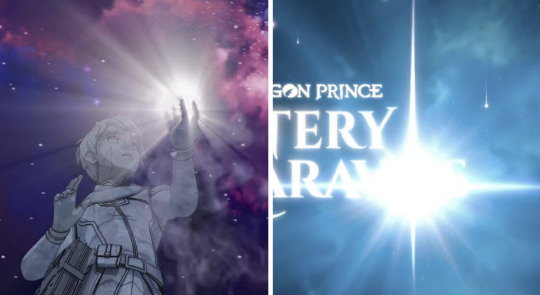
At the time, this was more of a guess. Most of the Star magic we'd seen at that point we weren't able to fully identify as such, it seemed a bit more magenta in colour, and while there was a parallel in the bright flash of light upon releasing Sir Sparklepuff, there's also a bright flash when the prison is actually made. It's just a good short hand for a crescendo of magical power, you know? We didn't know if quasar diamonds were even going to be white, besides the one presumably in Aaravos' chest concept art wise.
And yet — it still felt like something to me. Then S5 with Laurelion came along.
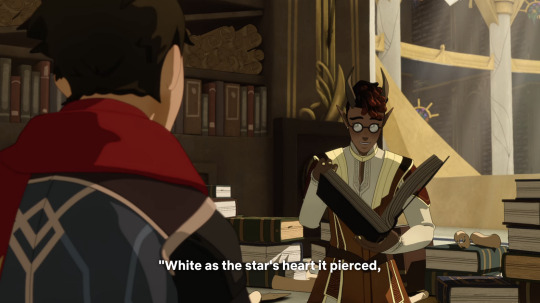
The Death of the Immortal
K: "And though undying, took last breath, immortal Laurelion was no more."
C: That's good, right? I mean when someone "was no more," that's — that's dead, yeah?
K: It's a bit confusing, but that is the clearest implication. Though it is somewhat odd they call them undying and immortal.
C: Well, that doesn't sound so immortal? Laurelion "was no more".
K: Right.
C: But how? How did they...?
K: Right here. "White as the star's heart it pierced, ivory draconic brought death's bite known ever forth as Novablade."
C: It's a sword.
There's a few noteworthy things about this whole exchange:
The poem has to be relevant eventually, otherwise why include it at all when you easily could've just had Kazi and Callum stumble across the sword period?
It confirms that the heart of a star is something that can be pierced, presumably removed, and white, which I think is the biggest "hell yeah" to the 4x04 intro
There is no reason to point out the contradictions in the poem itself unless A) the sword doesn't work the way we think it does and/or B) we are going to find out why the "undying and immortal" thing matters — and they make sure to emphasize the contradictions quite a bit as well, so they definitely want us to notice
If Laurelion died, and Aaravos took his place, that would explain how Laurelion — identity wise — could die while the same person under a new name could also remain alive / immortal
We learn in Rayla's pre-S5 short story that Ghosts don't often keep their real names, and take a new one as the final severance of their bond with their old community. For all extents and purposes, Aaravos was Ghosted (banished) from his community as well. Taking a new name would make sense
"That must've been when [Harrow] fell." "Fell? Fell! He didn't fall, Rayla, he didn't trip and fall on the ground — he got killed!" (2x08)
There's more speculation here regarding the actual sword and draconic ivory, but that is another post for another day that other smart people have made if you are interested. For now let's just focus on the heart.
We know Laurelion had a heart; we know it got stabbed with the Novablade, leaving Laurelion both no more (i.e. dead) and yet immortal / undying. We know that Arc 2 in particular has had an emphasis on losing your sense of self and identity ("I was his puppet" / "We can't save everyone, Soren" / "But I'm not evil. It's me" / all of Viren's dream visions). We know that a Star's heart is white. We know that Aaravos seemingly used to have one, and now it's either missing or impermanent, only visible sometimes.

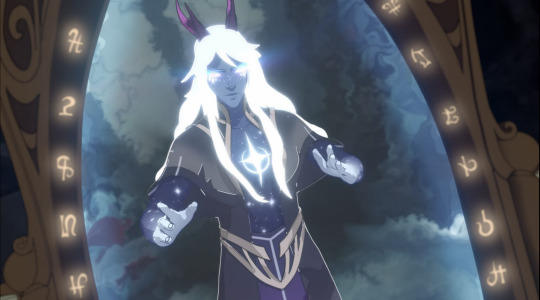
(Putting a pin in the second image cause we'll roll back around to it in the counter evidence section.)
We know his chest centrepiece glowed when he was imprisoned, and we know it was seemingly gone when he got banished. We know something about the Key of Aaravos was able to reveal his treachery.

I'm not saying any of this is for sure connected, but it does make you think, at least a little?
That, and it'd play into another bit of potential interesting foreshadowing / symbolism we got in s5 with
Viren Heart Theory
This is another theory I've discussed in more detail elsewhere, so I'm going to link to it here, but it wouldn't feel right to not talk about it at least a little here. Basically the theory is that Viren used his own blood / a piece of his heart, or possibly the whole thing, and the relic staff in order to save Soren when he was a young child.
This is largely due to Viren's spotlight turning red after he begs to be able to save Soren, and cinched by Kpp'Ar pointing specifically at Viren's heart only for Viren to deflect and start talking about Soren's case specifically. Whatever he did seemed to make him more 'powerful,' but at a great personal cost ("In the name of love you may perform acts that are so unforgivable, you will never forgive yourself") and something he finds the need to justify ("I had to do something! I had to save him! I had no choice!").



If Viren did this, it also adds another layer to Viren's sentiment of "Harrow's death breaks my heart" being well, half-hearted, in addition to Soren literally stabbing illusion Viren in the heart in 3x09. Viren mutilated his heart for his son's life, stopped being able to properly express love to said son, and then Soren stabbed his father right in the place that presumably saved him as a child. Ouch.
It seems likely that one of the reasons Aaravos was able to prey so aptly on Viren's desire for importance and attention — to Matter — was because Aaravos might've tried and failed earlier on to get the Startouch elves to listen to him pre-banishment. Being ignored, exiled, and disempowered is something he can relate to, and something he doesn't mind taking advantage of when it suits him.
However, if this combination could save someone Viren loved, it makes me wonder if Aaravos did something similar to likewise try (and fail?) to save someone he loved, too. It's either that or the Startouch elves just completely ripped it out, so... I guess we'll have to see?
But yeah — if Viren did it, then I'm expecting it's more likely that Aaravos did it, too. That is all.
The Pawn Intros
But Dragons, you say, didn't we already talk about the Callum pawn intro?
And to that I say yes, but — thanks to a promo S6 picture of Aaravos crying, we know something else very important about said intros that we didn't know before: they take place at the Sea of the Cast Out.
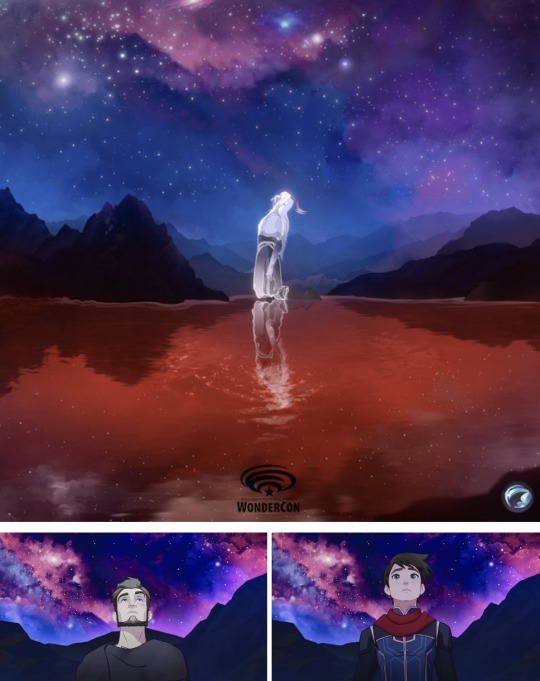
The sky, the mountains... the fact we know, thanks to the statues in 5x09, that this is likely where Aaravos' grief — his wound, if you will — began to bleed and take root, leading to his thousands of years of seeking vengeance and using just about anything or anyone he could. This is, presumably, where his chess game started... and where it is, symbolically at least, going to end.
Okay, so it's the Sea of the Cast Out — why does that matter?
Well, we know the Sea of the Cast Out is a site of literal trauma for Aaravos. We know, thanks to the statues of Aaravos and the Merciful One, that it plays into the same reaching motif we see Viren participate in quite a few times, both in his intro and in other places/relationships (most notably Sarai, Harrow, and Terry).
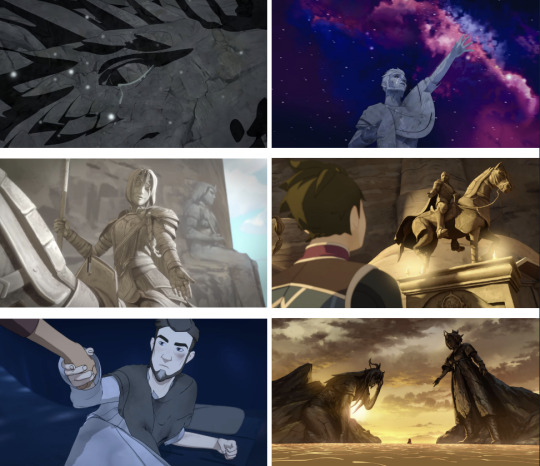
The Sea of the Cast Out is also, perhaps more importantly for this theory's purposes, near Elarion. What little we do know about the city beyond it being an important place for humans and dark magic ties it repeatedly to nature through The Midnight Star poem:
Elarion, trembling seed,
lay down to earth in icy night,
and in the cold
her roots took hold
defying winter’s deathly bite.
Elarion, fading bloom,
afraid to wilt and dim and die,
[...] Elarion, dying husk,
did wilt and whimper in the dark
[...] Elarion, black-eyed child,
her twisted roots spread deep and far,
as well as a tale about the Flowers of Elarion, precious blooms that could soothe the senses and turned to dust come morning—flowers that were left as "a fair exchange of beloved for beloved" (Tales of Xadia). Put a pin that Exchange idea because I swear we're gonna come back to it but not in the usual way you might be expecting, or at least not entirely.
And we have good reason to believe this nature motif is tied to Aaravos' current imprisonment as well, given how present flower imagery is for his mirror.
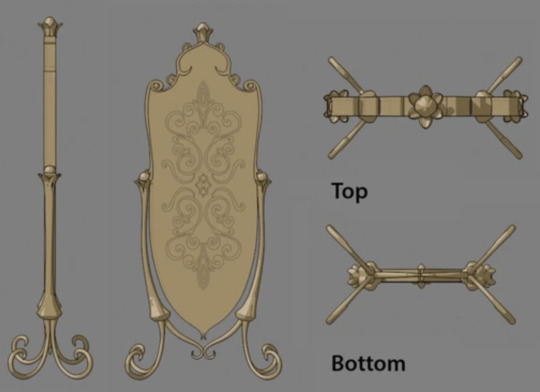

So the Sea of the Cast Out and Elarion seem to be the two places we know of thus far that are not only the most important to Aaravos, but the most instrumental to his banishment. It would not surprise me if either Aaravos got involved in what would become Elarion either because he was banished, or it was what he was banished over, or if discovering the truth of what happened there is likewise why the Archdragons were partially like "Yeah, we gotta lock this guy up" (now that they knew he posed a serious threat). The fact that Elarion is referred to as a child (everything with "blood of a child,"), black-eyed (which denotes dark magic), and winter's "deathly bite" ("White as the star's heart it pierced, / ivory draconic brought death's bite") just all ties together nicely in being related even if we're not totally sure how.
But Aaravos having his chest piece removed by force / as punishment in addition to being cast out by the Startouch elves, or him taking it out himself and giving it to someone who was lost... There's a lot of roads to get here as to why this stuff all seems connected if the Key is indeed his chest piece, which offers up both a power up, a sad tragic backstory, some baller symbolism, and some nice double meanings as to what it is key wise.
As the Key works in the moment, it doesn't seem like it's something that would be very useful to a primal mage, as other than pretty easily identifiable gemstones they wouldn't be using much the key identifies. However, the function of the Key being able to categorize and sort magical creatures and plants from each other is something that is very useful if you're a dark mage and need to shore up your ingredients list.
If the Key has Aaravos' chest piece in it, there are two main prongs this offers:
It may have been instrumental in helping humans discover dark magic, hence the "Elarion, searing white" and could also be the Gift the poem speaks of. Aaravos removed it himself (love makes you weak?), gave it to his chosen human, chosen human died, and he was locked out of Startouch realm as a combined result. This offers the clearest connection between why Aaravos' mirror has the nature motif and why Aaravos is crying in the beginning of 6x01.
It was removed by the Startouch elves and lost/hidden, forcing Aaravos to be away from his old home until he could find it again. This is the clearest explanation as to why the Key might be relevant on a plot level. It could give him the power up he needs to get out of his prison and barring that, it's what he needs to wreck havoc and gain access to the Startouch elves to get revenge on them
It also allows what we learn of the cube in 2x06 to have multiple meanings:
The Key is revealed in an episode called The Heart of a Titan. We're led to assume that this is just the Magma Titan, and you could perhaps make an argument the dual meaning (just like how Breaking the Seal refers to the letter and the titan's chest) refers to Harrow or Callum's capacity to love. But, given that one of Aaravos' most prominent mythic comparisons is to Prometheus, a literal Titan, well...
"It unlocks something of great power in Xadia" would work equally well if it's a Key literally made from Aaravos, not just to Aaravos. And the past 2 seasons in particular have emphasized over and over again just how powerful and dangerous he is
The salvation and destruction motif that is inherent in the key, ("I just have a feeling this key thing can help me" / "It's the key of Aaravos, no good will come of it") as keys are linked to chains and freedom with the ability to lock and unlock, is rampant in 2x06, as Viren states that Xadia and the Magma Titan "held both the promise of our salvation and threat of our destruction." This goes double for Sarai sacrificing her life to save Viren
And to round back to Viren and his intro, I don't think it's a coincidence that

is one of the first things Aaravos ever says to Viren, particularly when trying to earn Viren's trust. (Nor that Aaravos considers that Zubeia and co. "betrayed" him when "he would lower his guard," just before the imprisonment.) And while Aaravos gains Viren's trust as a political ally here first, it's also clear that he's actually primarily preying upon Viren's deepest emotional desires here as well: to be listened to. To matter.
Viren wasn't listened to by the monarchs around him (Harrow). He wanted to be important (to them). He wanted to matter.
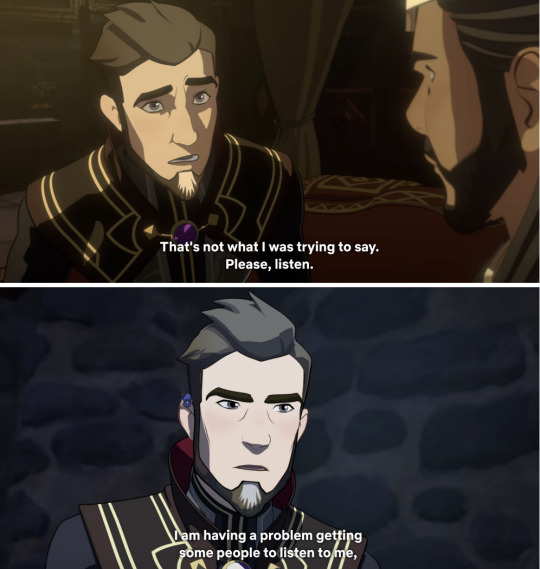
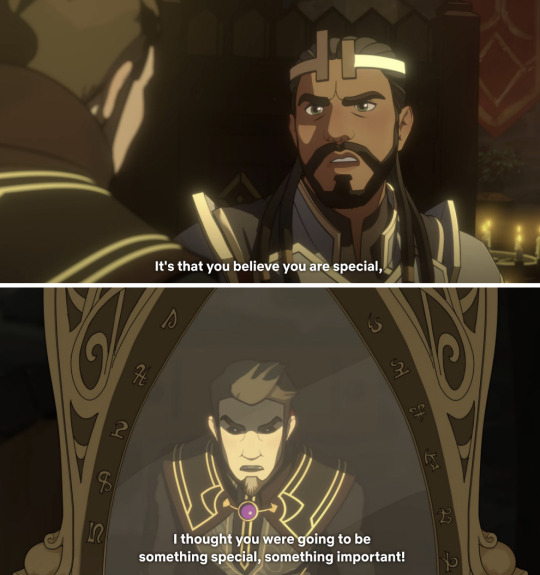
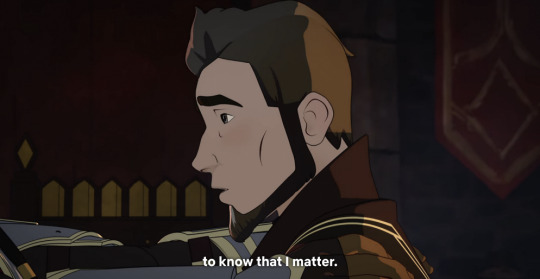
"It is everything to me, to know that I matter. It's all I ever wanted."
Aaravos: Search your heart. There is something you want very badly. (2x09)
Zubeia: He was able to give them something they wanted very badly. (4x04)
And that's what Aaravos offered him, with power and knowledge just being the bait. (If you're interested in more detailed thoughts on this aspect of Viren / their dynamic, check out this meta here.)
More to the point, I do lean towards the Key's plot purposes being 1) a power-up that may be needed for him to get out of his mirror and 2) something that likewise allows him to see the other Startouch elves again. After all, the Silvergrove gave each elf a similar kind of key:

But y'know what, let's talk about Rayla now, because
The Missing Piece of Your Heart
As stated earlier, Rayla's letter has a consistent metaphor when it comes to family and loss:
I remember how I felt when my parents left me to join the Dragonguard, like PART OF MY HEART WAS MISSING and I would never feel right again. I thought I hated them when they did that to me. In the beginning, it felt so big and terrible—like raging despair—but, overtime, it became a soft, sweet ache—a reminder of that missing part of my heart. [...] Please don’t let this hurt too much. But, if it does—if you feel that soft aching—know that that piece of your heart isn’t missing. It’s not missing at all, Callum: I’m carrying it with me! Always.
This struck me as interesting when the letter first came out, as it was a departure from most of Rayla's previous heart motif ("My heart for Xadia") and even the one attributed to her one half of her parents ("My heart goes out with this one"). Why have the motif suddenly switch up when it would've worked just as well, or been doubly romantic + a Ruthari parallel, to just have it be the whole heart?
Then season four came out, and I understood, because, well...
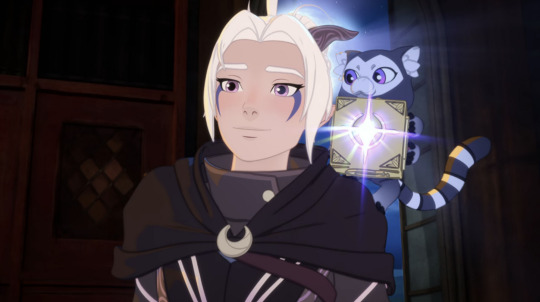
Upon her return, Rayla brings back that "missing piece" of "Callum's heart". It's a painful restoration and doesn't run entirely smooth, but in season five in particular we see him be much more like his older, happier self once he's let himself love her again, and how steadfast he is in said love ("To love is simply know this...").
But, in a moment that could've been exclusively about Rayla, nor did it need for Stella's connection to the Star arcanum to be this prominent in the same moment, they choose to likewise highlight Rayla 'bringing home' the missing piece of Aaravos' heart, too.
This symbolism is also consistent with how the key is introduced in the first place, i.e. first thought of because Rayla's drawing in Callum's sketchbook (another gift from Harrow) reminds Callum of it, and her ultimately being the one to retrieve it even once things at the Banther Lodge take a turn towards the south.
Furthermore, we do have reason to believe that Rayla is indeed the 'Key to Callum' in a sense, particularly after 5x08. Just like how a key can both lock and unlock — give freedom or entrapment — Rayla symbolizes a great deal of duality in Callum's life, including but not limited to:
Leading him to primal magic (1x03, 5x08) and dark magic (2x07, 5x08)
Light ("No one can control you or make your choices for you" / Ray of light) and dark ("But the second you see that elf girl in pain, you completely lost yourself" / "Stay safe, and stay in the light. Don't look for me")
Being routinely emphasized in Callum's arc with Aaravos, especially in S4
"Now you're back. That's kind of good, and it's kind of bad" / "You have to hold pain and love in your heart at the same time" / "And when she came back, I was so happy, and so mad at the same time"
Salvation ("Rayla saves people [...] that's what makes her a hero") and destruction (being willing to die / do dark magic for her)
The Ocean arcanum realization being both positive and negative, just as the poem itself takes on a different shape across the season in regards to how Callum views her and how he views himself while being motivated by his love for her / Ezran
“Wow. So [the berries] look identical, but they might kill you or they might save you,” Callum said.
“Exactly. Just like me…” Rayla smiled.
—Book One: Sky novelization
If you're interested in a more specific meta on this dichotomy, I recommend this meta written pre-s4 and this more recent one about 5x08 specifically.
I've written before about Rayla have a weird consistency with the cube as well, particularly in her being the primary carrier of its foreshadowing for most of arc 1, with Callum only really doing so in 1x04 and having Rayla pick up the slack the rest of the time:
"It's a toy, a piece from a children's game" (1x04) as well as "It's a glow toy" (1x05) are now literally true as the cube is 1) involved in Aaravos' game and 2) literally glows a bright flashing light circa the 4x04 intro.
"Are you practicing magic or are you losing to Bait at a game of rolly-cubes?" (2x07 right after Callum calls it a key) came to pass, somewhat if not outright, it seems, in 5x08. Callum practices two different magics, Rayla is literal bait in exchange for the glow-toad, and the episode ends with Callum being worried he's potentially losing Aaravos' 'game' so to speak — that he's made himself more vulnerable to the Startouch elf's control.
Two lines of hers regarding the cube that have not yet come to pass are "This doesn't end well for you" (1x05) and "I hope it was worth it to you, putting everyone's lives in danger" (1x04) but I expect that we'll get them soon enough.
Rayla's 'tether' to a the cube does, of course, loop back into the Flowers of Elarion tale, in which there was a fair exchange of beloved for beloved. If the Key does indeed hold Aaravos' heart (and that is still a very big If), whether it would include an actual exchange is still debatable, but it seems inevitable that she would at least play a part. (If you're interested in more thoughts on Rayla + the cube, check out this meta pre-s4.)
Where the game motif gets the most interesting, I think, is where it intersects with the idea Aaravos mentions in 2x09 regarding, "Those who fail tests of love are simple animals," and one of the TDP short stories in particular having one very interesting tidbit:
“My behavior is—?”
“—unusual,” Corvus repeated, nodding. “Very unusual. Ever since you started challenging me to all these little games.”
Soren squirmed. His pauldrons clanked as his shoulders slumped. “They aren’t games. They’re tests. Ugh…I’m really messing this up.”
Since Rayla is going to have her "My heart for Xadia" undeniably tested, it would make sense if Callum and Aaravos' hearts came into play too, don't you think?
Other Misc Symbolism / Oddities
Last but not least, we have our odds and ends that didn't fit in the other sections, but I thought may be worthwhile to mention anyway.
For starters, we have screencaps (most notably in 3x06) where you can see a visible dip in Aaravos' tiddies chest that indicates something was removed, and it's not just an artificial darkness.
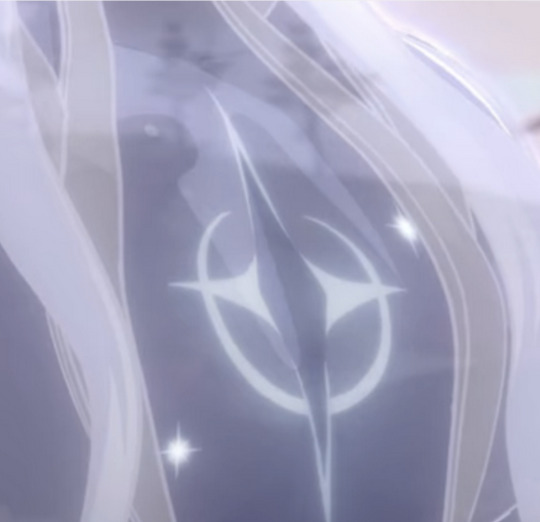

We have Aaravos touching a fist to his heart twice before he bows and indicates that Callum is going to "play" into his hands (remember that game motif?).
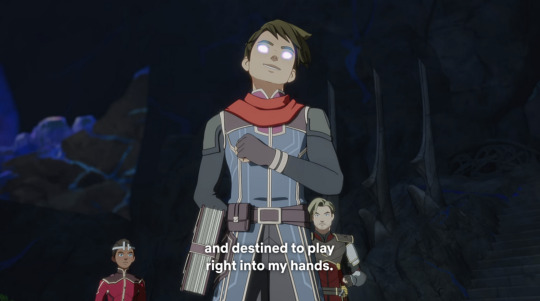
We have this shot, which is the exact kind of thing that "crew makes sure the Ocean and Moon runes are most prominently on display in Callum's dark magic dreams to foreshadow him doing dark magic in S5 Ocean for his Moonshadow gf 3 seasons later" would absolutely do and think they're So Funny about. "No gem for star magic" except the one you're unknowingly holding in your hand, am I right?
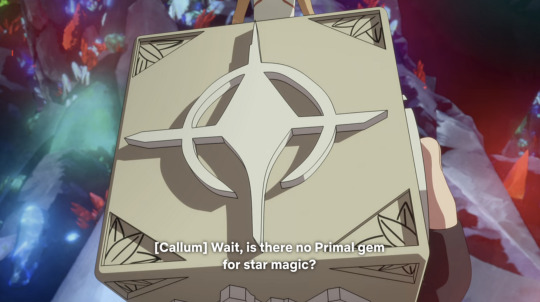
Finally, we have precedent that dark magic can 'darken' your heart both in show when Amaya passes the light trial ("A human that is pure of heart") and in the graphic novels with Claudia ("Your heart is not yet darkened") which allows her to see the map to a unicorn (The Puzzle House).
@self-spaghettification also noted that the bright white flash of the star in the 'o' of Aaravos' name in the Arc 2 intro momentarily looks like and makes the shape of the Nova Blade, which is also very cool.
Honourable mention to Rayla going "it's a piece from a children's game" and Ezran going "you said each of the archdragons had a piece of the puzzle" and the Orphan Queen and Jailer presumably working together to trap Aaravos. I think about that shit every day.
Evidence to the Contrary / Alternatives
But like I said at the start, there are plenty of alternatives or feasible pitfalls to consider. This theory resides on a few assumptions after all, that may not be true, such as Aaravos not actually needing the key for anything other than as a lure for Callum, it could purely have something to do with the Nova Blade and nothing to do with the prison, or even have something to do with the nature of magic itself, capable of great good as well as great evil.
His chest piece could've always been more immaterial and dark magic has just darkened it rather than it being removed. Aaravos may have stabbed Laurelion in order to use that heart diamond to partially make the Relic Staff he passed onto Ziard, or Aaravos' chest piece could be in the staff itself, and the cube is something else entirely.
Conclusion
In the end, as we go forward into S6 all the above is more less my personal bet as to where I think we really could go in terms of answering a lot of these questions we've had for a few seasons now. I hope you enjoyed reading the theory and considering (and possibly subscribing to) it, as well as getting your own thoughts stimulated. If any of the above happens I will cry for days and no matter what, I am deeply intrigued to see where S6 takes Aaravos' backstory and, of course, his cube. Luckily:
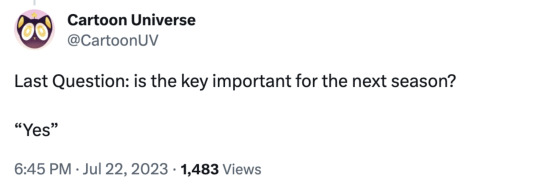
91 notes
·
View notes
Text
Blake Belladonna's Design
This is a quick appreciation of our Cat Girl's design. Its objective is to offer a short analysis by incorporating elements of other metas. Ideally, the end result will be something similar to Yang's post. Finally, this is the final piece of my mid-summer Blake meta spree :) So, enjoy!
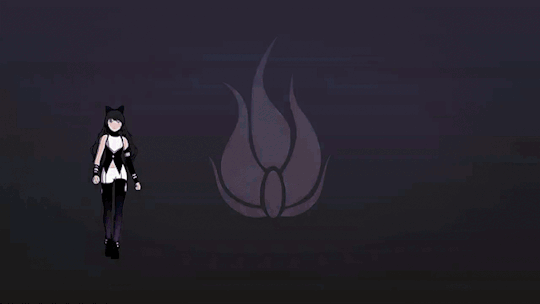
JUST ANOTHER CAT GIRL?
Blake's design plays with the idea of "cat girl". Cat girls are common in anime and mangas, but are often overly sexualized. In particular, cat ears are usually presented as an overly cute trait and sometimes a fetish.
RWBY takes this idea and subverts it in 2 ways.
Blake's ears are initially hidden, so that her affinity with cats gets highlighted through other aesthetical elements:
Gambol Shroud's ribbon resembles a cat's tail and it being a whip may reference the infamous cat o' nine tails
She decorates her eyes with cat eye makeup
She is able to make copies of herself, which get jokingly referred to as copycats
In Mistral she wears leg boots, which bring to mind Puss in Boots
In Atlas she wears a catsuit
Blake's cat trait becomes a core part of her identity, which is explored on a double level:
It represents her faunus heritage, which makes her different from humans and discriminated
It is a symbol of Blake's troubled past and of her involvement with the White Fang
So, Blake covers her cat ears to run from both society and herself. Just like a scaredy cat ;)
As you see, with some limitations and worldbuilding, Blake manages to be a cat girl with much depth to her. Still, there is more to her cat design.
FROM CALICO TO TUXEDO
Let's juxtapose Blake's initial concept art with her final design:


What changes is the cat used as the main inspiration.
In the initial concept art it is the calico cat (tricolor cat):
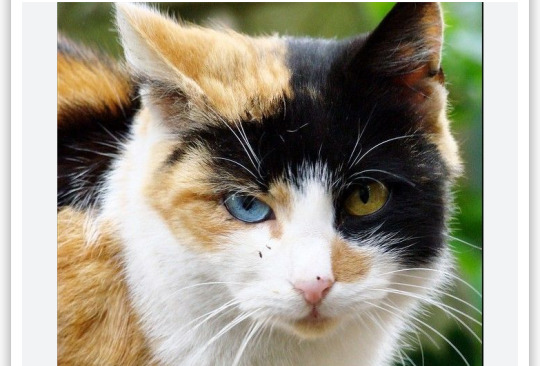
In the final character design it is the tuxedo cat (bicolor cat):
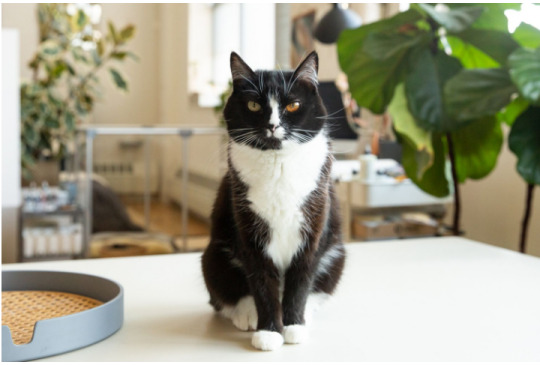
Why the change? Let's explain it by highlighting one similarity (1) and one difference (2) between the two kitties.
1- Both cats are called after a type of cloth:
Calico is a fabric, which originates in India (the set of the Jungle Book - Blake's secondary allusion) and is famous for its colorful printed patterns. I wouldn't be surprised if Blake's clothes in the concept art were meant to be calico made.
Tuxedo is a formal wear, which consists of a black suit over a white shirt and a bow tie. Well, Blake's final design is a revisitation of the traditional tuxedo with a shorter jacket and a bow worn in the hair, instead than as a tie.
The idea of "cloth" is heavily used in Blake's design, which may be one of the reasons why the tuxedo is eventually chosen. This kitty, thus, offers a pretty poignant metaphor.
It all starts with Gambol Shroud, where shroud means a piece of cloth that conceals or protects:
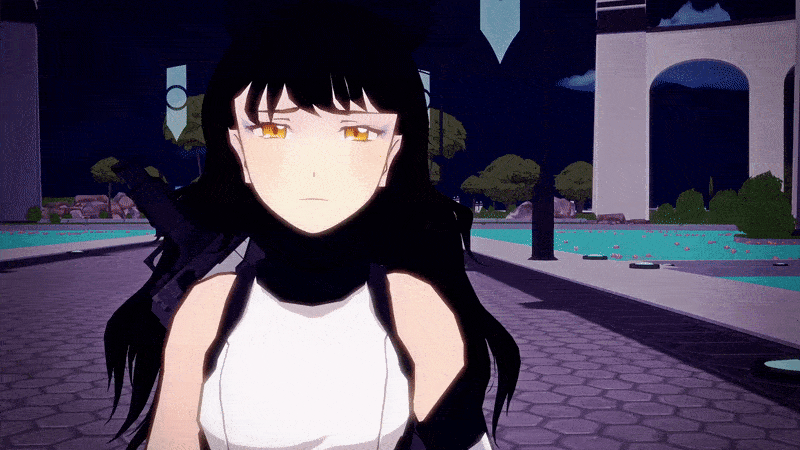
Here come two thoughts:
Blake's bow is her shroud which is why it resembles her weapon’s ribbon (same color and similar material). The bow is the ears, while the ribbon is the tail. Together they complement Blake’s cat design.
Some tuxedo cats are called tuxedo masks because it is as if a black mask covers their whole faces. It is easy to see how this concept fits Blake, who conceals herself thanks to a little piece of fabric.
Basically, Blakes's bow is her tuxedo tie, which is worn as a mask.
2- The two cats differ when it comes to their color:
The calico is a tricolor cat, which is mostly known as having a white coat with some orange and black patches
The tuxedo is a bicolor cat, which has white and black fur
These two color patterns are another reason why Blake has been characterized as a tuxedo instead than a calico. As a matter of fact the black and white dychotomy fits our beautiful faunus girl more.
WHITE AND BLACK = BEAUTY AND BEAST
In old English, Blake's name means both black and white. As a result, she is linked to both colors, which tie with her light and shadow motif:

Blake is associated to the twilight because it is where light and shadow meet. What's more, her musical theme is built on this duality. She starts in the shadows and climbs her way up towards the light.
Well, Light and Shadow are linked to two Jungian Archetypes:
The Light is the persona, so what is shown to others
The Shadow is what is repressed, so the hidden parts
And these two archetypes are explored in The Beauty and The Beast:
The Beauty is the light - she is beautiful, lovable and accepted
The Beast is the shadow - he is ferocious, scary and misunderstood
So, Blake's own allusion can be read as the integration of beauty and beast, light and shadow, so that a new unit (a new individual) is born. This is also Blake's arc in a nutshell. She starts as a shadow because she hides herself, but with time she steps into the light and shows the world who she is.
In other words, Blake's Beauty and Beast allusion is referenced in her appearence not only in her nature as a faunus, but in her color scheme too. She is both beauty and beast, light and shadow, white and black.
This is also why these two colors are incorporated in respectively Sun and Ilia.
Sun is white, as he leads Blake towards the light:
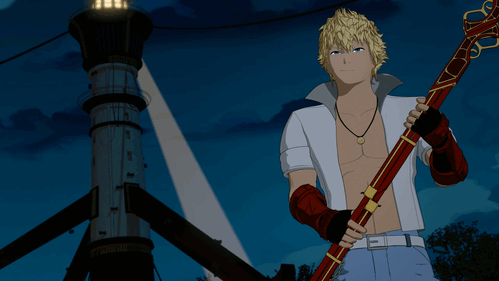
Ilia is black, as she forces Blake to face her own shadows:

Through them Blake integrates her shadows and stops hiding:

This is why her design changes in Mistral in two notables ways:
She gives up her bow once and for all
She wears a white jacket over a black top
These two details mirror Blake's inner journey. She learns to show herself more, so her ears get to be out in the open and the light (white) surfaces. In Beacon, instead, the ears are concealed and Blake is wrapped in shadows (black).
Ironically, this means Blake's design loses the core traits of her tuxedo cat inspiration. As a matter of fact she has no bow tie anymore and the color pattern is inverted, which doesn't work. Why this choice? It is because Blake is going from Beast (black + cat) to Beauty (white + individual). Symbolically, this happens as she shows her faunus trait more openly:

She grows more beautiful (human) as she openly embraces her beast side (cat).
GOLD, BLUE AND PURPLE = HOT, COLD AND JUST RIGHT
The shift from calico to tuxedo brings some consequences to Blake and Yang's complementary designs.
Let's compare the bees exploratory ideas:


As people have noticed, Blake and Yang are aesthetically and symbolically linked since early on.
Here, we have:
Blake with one gold eye and one blue eye
Yang with a blue bandana
This chromatic choice ties into Yang's allusion and design. As a matter of fact our Goldilocks uses colors to represent the too hot, too cold and just right. Specifically:
red/orange is the too hot
blue/green is the too cold
purple (blue + red) is the just right
So, in the picture above Yang's looks play with the dychotomy between too hot and too cold. This same duality is mirrored in Blake:
She is both too hot (gold eye) and too cold (blue eye)
She wears much gold in general (Yang's main color)
The idea is clear. Blake is Yang's hot and cold. In particular, she brings some needed blue in Yang's life. She helps Goldilocks cool down and become more balanced. Similarly, Blake proudly wears Yang's golden tones, as she has to grow more like her Golden Beauty.
So, how have these ideas evolved in Blake’s final design?
Blake has gained a strong association with purple, which makes her Yang's just right
Blake's color scheme has ditched gold in favor of silver, which makes her and Yang complementary
Blake's link to purple is interesting because this color calls back to her family and to the surname Belladonna (beautiful woman in Italian). In other words, it is connected to both Ghira's legacy and her Beauty side. So, it is not a surprise that Blake grows more purple in each arc:

She is slowly blooming into Yang's just right by reconciling with her legacy and by becoming a person worthy of our golden girl.
This transformation is highlighted also by Blake integrating some gold into her:
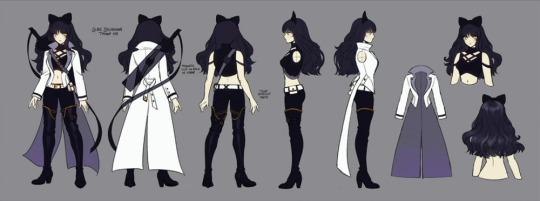
In both her Vale and Atlas's designs Blake is linked to silver, so that she can complete Yang's gold. Still, in Mistral she has some gold details because this is the arc where she integrates her missing parts. This integration ends with Adam's death and Blake's rebirth:
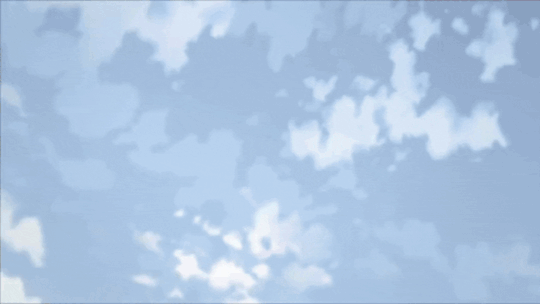
So, Blake's design tells a story of inner growth, which leads her to stand beside Yang as an equal:
Blake: She's not protecting me, Adam. And I'm not protecting her. We're protecting each other.
This theme is important for Blake's Cat Girl archetype. Cat Girls, thus, are often reduced to love interests, but Blake's arc is a deconstruction of this idea. What would happen if the male partner of a Cat Girl is abusive? Blake explores this concept and tells a story of liberation and development, which ends with a reconstruction of the trope. Our Cat Girl ends up in a happy relationship, but not as a shallow prize. Rather as a winner.
BEASTS, LIONS AND WOLVES
In conclusion, Blake's design alludes to the Beauty and Beast on three levels:
Society= Blake is both human (beauty) and animal (beast)
Couple = Blake and Yang are drawn as complementary
Individual = Blake is both white (light) and black (shadow)
Still, this is not the only fairy tale our Cat Girl ties into thanks to her animal features. Here come three examples.
Blake is Bagheera's daughter and a small panther (a cat) in the Jungle Book
Blake is a Scaredy Cat to Lioneheart's Cowardly Lion. Except that of course the cat is braver than the lion
Blake is Ruby's black beast in team RWBY's LRRH team allusion
This last reference is foreshadowed since Red Like Roses:

Black the beast descends from shadows.
After all, the Beowolves appear when Blake's line comes up.
Moreover, Blake's secondary allusions all come together to strongly link our Black Shadow to wolves. In the Jungle Book, Mowgli is raised by wolves, just like Blake grows up in the White Fang. The name of the group itself calls back to wolves, as it references the title of Jack London's book about a half-dog half-wolf, who fights to be accepted by humans.
Finally, it turns out Blake is not the only Cat, who turns out to be a Wolf:

In short, Blake's design lets her freely move between allusions and references. Not only that, but it is crafted to add depth and thematic resonance to her character and her arc. Not bad for just another Cat Girl, uh?
#rwby#blake belladonna#rwby meta#my meta#yang xiaolong#bumbleby#character design#once upon an allusion
209 notes
·
View notes
Text
Dressed to the Neins 2 - Scanlan
Tumblr gets the design meta that’s too long for TikTok:
When I’m picking a pattern and colours for these, I’m looking at character art, I’m thinking about the character, and sure, a lot of it is picking pretty colours that go nicely and fit the vibe - but there’s a bunch more to it than that. It’s real ‘the curtains are blue for a reason’ hours over here.
imagine there is a brown and white square underneath a pink and purple square, and then a hand reaches out and pinches the pink and purple square in toward the centre on both sides, letting the brown and white square show underneath. Almost like hands extended in friendship peeling back a mask to reveal a soft underbelly. Visual metaphor!
the Juniper green and Pike blue colours are at the centre of the square to represent things Scanlan values most highly in his heart of hearts - not just Pike and his mother themselves, but what they represent - genuine love and family
the ‘heart’ rounds are then bordered by a thin round of the same purple as the background - this is the Scanlan colour
the quatrefoil shape is made up of alternating rows of lavender and magenta - colours that are close to, but not the same as, the Scanlan purple. This represents the flamboyant, carefree, rakish persona Scanlan spends a long time inhabiting - one which isn’t exactly him, in the end
the brown and white ‘underbelly’ rows represent a simple gnome of humble origin. These colours carry on in thinner stripes through the quatrefoil mostly because that’s how the pattern works, but I think it makes a nice representation of how that first Scanlan is never really gone, no matter how deep into his own mythos he gets
similarly, the background is purple because as much as the colourful layers are a persona, that persona is also not not Scanlan
the border row is the Juniper colour again to emphasize how important family is to Scanlan throughout his story - Juniper’s death and Kaylie’s life being major turning points for him
Pattern: ‘Lise’ by Polly Plum (free on Ravelry!)
Yarn: Sweet Georgia Tough Love Sock in Birch, Bison, Evergreen, Summer Sky, Lavender, Huckleberry, Jam Tart, Dark Orchid
#critical role#vox machina#dressed to the neins#scanlan shorthalt#crochet#granny square#cr fanart#fiber art
71 notes
·
View notes
Text
I haven't done any cinematography/camerawork meta analysis threads recently and it's making my brain itch. So here's a small analysis of how negative space is used in the show to express characters' emotions. This is the first in a series.
The use of greenery in negative space in episode 1x7: This Is Happening
First, Jim stands alone in a field with Olu small in the distance, reflecting Jim's mindset of being on their own, isolated. We know from Olu that Jim doesn't talk much about their personal past, and this shot is right after Jim confronts their past, which turns negative.
They isolate and go to their old land, seeking comfort in the openness and of the past: where everything changed.
Olu follows them, not leaving Jim alone in this vast negativity: literally and figuratively.


Next, Olu and Jim face each other, with space in between them, a stone wall behind Jim, and open space behind Olu. This once again reflects their mindset.
Jim opened up to Olu, telling him the truth about their past, introducing him to the person that raised them. Shooting them in profile, completely facing each other shows how open they are now after that previous shot: they are on equal footing, no longer Jim with their back turned to Olu in the distance.
While they are drawn to one another — they almost kiss — what is behind them foreshadows the end of the episode.
Jim still has a wall behind them — they have decided to continue on their journey of revenge — and therefore must leave. Olu on the other hand, has open space behind him because he is open to Jim and whatever is happening between them.

Now moving into the A storyline of Lucius, Ed, and Stede. This overhead shot consists of mostly neutral colors, the only pops are the fire, the purple of Ed, and the green leaves. Ed and Stede sit right next to each other, but their bodies are turned inward, knees almost touching. (This exact same position happens multiple times throughout the show including in 2x4 on the couch in Mary and Anne's home.)
The green is attached to the humans, especially to Ed and Stede, and it being the main pop (along with a kindling, warm fire) in this scene reveals what is important in the scene: the people.

When we move to the two shot, Lucius still dirties the shot in the foreground, but the focus is on Ed and Stede. Just like with Olu and Jim, there is a small space between them and larger space on each side, particularly the green is more on Stede's side, but Ed's purple shirt — which shows his growing feelings for Stede — is out and proud.
That kindling, warm fire is now shown between Ed and Stede, bringing that metaphor up front in this angle.
This whole episode is Stede subconsciously trying to get Ed to stay. His space on his side is open and green, just like his feelings for Ed.
A large palm tree sits behind Ed in his space because his feelings are shown through his purple shirt. Just like Stede, he has growing love for him but isn't as open at this point. (Lucius talks to him about not being a dick and Stede has feelings for him.)
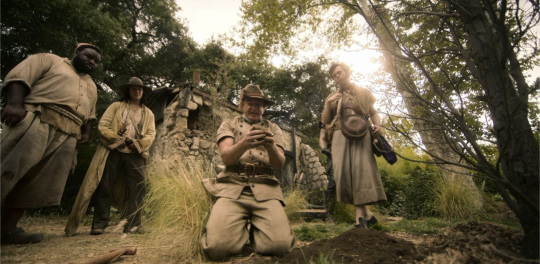
I also love this shot when both the A and B plotlines merge together.
Stede is in the same position as when he looks at the ruined, burned map, but this time he's excited, he found the treasure. Ed and Lucius are on one side and Jim and Olu on the other, Stede bridging the storylines and characters.
Greenery, the stone wall, and particularly the sun are the bright spots in this shot of mainly neutral colors. The sun shining down on all these characters shows how their relationship has changed since the previous shots/beginning of the episode. Olu and Jim are about to split up so they stand in more darkness, while Ed and Stede are right under the sun, the light that is used throughout the show to represent their love (especially Stede's — but that a whole other post I'm working on) is bright and center.

And I'll end with this shot, which unfortunately is cropped, but in the full shot there is open space on either side of the couple. But luckily I want to focus on the space between Ed and Stede. The space here is bridged by their hands touching and holding the petrified orange. (Later on, Stede talks to this orange, calling it Edward in symbolism of his new versus old life).
Stede and Ed parallel Olu and Jim's earlier shot of facing each other but they complete the gap and touch. Their relationship has changed by this point, they are closer: emotionally and physically.
The negative space used in these shots show us the emotional state of the characters, from the green space around them showing their isolation, to by the end the greenery space shows how they have become closer.
#ofmd#our flag means death#cinematography#meta analysis#ofmd meta#jim jimenez#ofmd stede#ofmd stede bonnet#stede bonnet#oluwande boodhari#ofmd oluwande#lucius spriggs#ed teach#ofmd 1x7#this is happening#ofmd edward teach#edward x stede
64 notes
·
View notes
Text
Queer Metaphor and Queer Literality
People have been comparing Our Flag Means Death and Good Omens a lot, but the similarity that stands out most to me is on the meta level of how they do their storytelling. I think they both feel like a similar flavor of meaningful queer story because they depict queerness at both a literal and a metaphorical level, where the positive elements occur at the literal level and the negative elements are depicted through metaphor.
On a literal level, both series are full of explicitly, textually queer characters who have actual romances with kissing and everything. Characters can be trans and express their gender in non-normative ways without reprecussions (mostly). There's almost no depiction of overt homophobia onscreen. I'm not sure whether Neil Gaiman or anyone else involved in GO has talked about this choice, but I know David Jenkins has said that he wanted to avoid making the characters in OFMD constantly deal with homophobia and queer trauma. It's not that they take place in queernorm worlds, exactly; it's more that the bad stuff largely happens offscreen. (I've addressed this in an OFMD meta about season 1.)
But the thing is, neither show actually shies away from depicting homophobia and queer trauma - it's just that they happen at the metaphorical level.

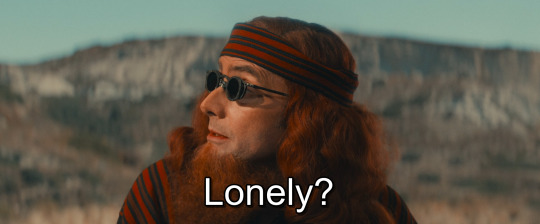



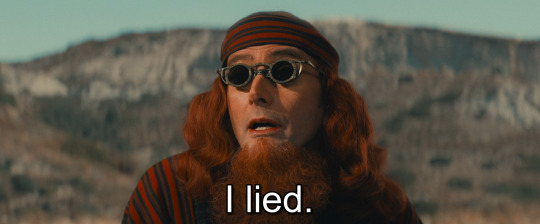
In GO2, both Crowley and Aziraphale's relationship to heaven and hell is, metaphorically, that of queer people to a stiflingly heteronormative society that will never truly let them belong and be themselves at the same time. They find community in each other - they are the only people in the world who have experienced the things they've experienced (and isn't that a relatable queer feeling!), and they also find community in queer humans, in a way. But to their home societies that originally gave them belonging and purpose, they're outcasts, and that's very lonely for both of them. They both deal with this very differently; Crowley abandons heaven and hell entirely and embraces his outcast-hood and independence (even though it's still lonely), while Aziraphale still longs for that sense of belonging and eventually decides to try to assimilate again (even though he can't really be himself there).
There's a lot more you can say about metaphorical queerness in GO (like in this recent Tor.com article). But basically, Crowley and Aziraphale's differing reactions to the ostracism of their native society mirror two different ways a lot of real life queer people respond the ostracism of their native societies, even though Crowley and Aziraphale themselves don't really face explicit homophobia for their queer romance onscreen.
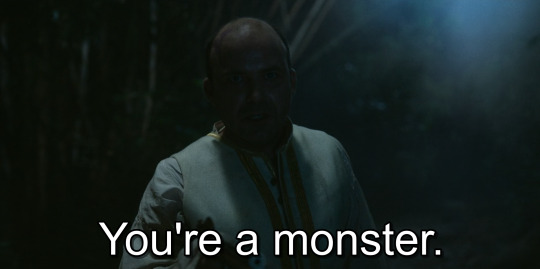


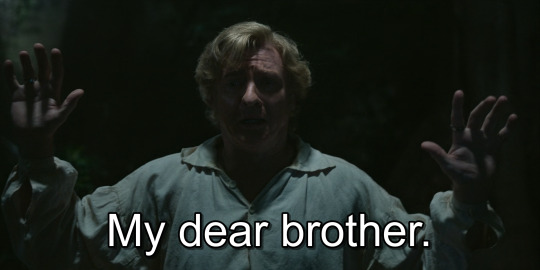


OFMD intertwines the metaphor with the literal in a different way. In a way, piracy is a metaphor for queer community; we've all heard Izzy's "piracy is about belonging to something" line in the trailer (even though we don't know the context yet.) But pirates also commit acts of violence, and most people consider them horrible monsters. Stede and Ed both struggle with feelings of monstrousness that are about their piracy-related actions on the surface; but those feelings are instantly and horribly recognizable to a lot of queer people. Chauncey Badminton's "you defile beautiful things" speech is burned into my brain in part because that's exactly what my internal monologue sounds like sometimes (and I think you can pretty easily interpret that speech as being about Stede being literally queer as much as it's about Stede killing his brother; Badminton comes just short of outright saying it.)
When Stede leaves Ed, Ed dives headfirst into being the monster everyone believes him to be. He hates himself; he thinks he's unlovable; he commits as many atrocities as he can in the hope that someone will put him down, and he'll deserve it. I think he feels that Stede left him because Stede, too, saw him as an irredeemable monster, and he tries to make it true to justify his own self-hatred. Ed's self-destructive rampage is an over-the-top expression, in the context of a pirate story, of some deeply recognizable and relatable queer emotions. It's easy for society to make us feel monstrous; Stede dealt with that by trying to remove his influence from the world and return to the (heterosexual) status quo, and Ed dealt with it by trying to live up to the monstrousness he felt inside himself until it destroyed him.
I think one reason these two shows have been so effective - and been effective in similar ways, to more or less the same group of fans - is that this combination of literal queer joy and metaphorical queer suffering feels like a very deep, authentic, relatable portrayal of queer experience. It's fun and wish-fulfillment-y, and avoids getting too close to the reality of the negative experiences a lot of fans have probably had. But at the same time, it filters those negative, complicated, and familiar experiences through the lens of the fantastical, which gives them a certain clarity and emotional grandeur that they couldn't have in a work more true to life.
I'm pretty skeptical about equating "representation" to quality (I've read a lot of deeply mediocre queer books), and I don't think it's quite accurate that these shows have been so successful simply because they depict queer protagonists in queer romances; I think that take misses something, because in this day and age, there are a lot of queer romances out there and easily accessible. But I think the way queerness is embedded into multiple levels of storytelling in both these shows gives them a lot more depth of meaning and emotion, and I think that's a big part of what fans have latched onto.
#our flag means death#ofmd#good omens#ofmd meta#good omens meta#ofmd stede bonnet#ofmd blackbeard#ofmd os#ofmd s2 spoilers#ofmd spoilers#ALSO if you like stories that are queer on both literal and metaphorical levels of storytelling#please watch revolutionary girl utena and sarazanmai
116 notes
·
View notes
Text
M*A*S*H 4077 & DND
guess who started their m*a*s*h rewatch around the same time they've gotten into d&d and now cannot stop thinking about the utter chaos and hyjinks of The Gang trying to play a campaign. it starts with none of them really super into fantasy roleplay, but they're all So Fucking Bored they might as well play to have something to do.
it started off imaging just what role they'd each play, but now I couldn't stop myself from imaging each person's race, class, AND, just for fun, the dice they'd use!
hawkeye: isn't that bothered about races, probably either an elf or just a human. class is paladin, relating the paladin's 'call for good' something like the oath doctors take to always help and heal patients, no matter what (and, let's be honest, probably feeds into his egotistical nature at being a naturally skilled surgeon, as if he was 'called'). cannot be Asked to care about ability scores (only to deeply regret it when he's nearly off'd the first battle) except for pouring most of his points into charisma. mostly likely of the party to Fuck his way out of a confrontation (no matter the other's gender #bihawkrights). spends most of the campaign messing around and forgetting what his spells are, but when the party hits a serious battle, is the first to throw himself in and use any spells to help his friends before himself. originally wasn't that interested in the game, but overtime becomes one of the ones who gets really into it, screaming across the board at ppl's bad roles and cheering & trying to pick ppl up in glee when they win.
dice of choice:

(just the most wack-ass coloured dice I could find, metaphor for the inside of his brain (also this way he can tell if anyone tries to conceal any as theirs)).
radar: while interested in the fantasy stuff (being a comic reader), was a little intimidated with all the math & rules involved until hawkeye and bj convince him. part of me thinks he could be a halfling or dwarf, but then I think he might enjoy being a humanoid creature like a minotaur (farm boy) or a satyr bc of his love of animals. class is bard, where he carries/plays the drum. enjoys and gets really into the story, but is always flummoxed when it comes to the battles, asking what everyone else thinks his character should do (only for everyone to yell back several different answers). always needs a couple of seconds of mental math to add his modifier to dice rolls (me too radar) but when the party comes across a riddle or puzzle, is usually the first to figure it out. keeps trying to pick up small creatures to put them in his sack. is not allowed to talk while people make their roles bc of too many times where he's predicted the number before they can read the dice (the moment of hawkeye's saving role during a Big Bad battle was kind of ruined when radar elatedly jumped up at the nat20 before the dice even left hawk's hand).
dice of choice:
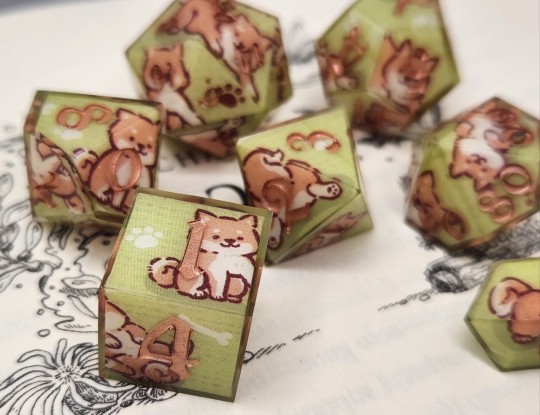
(cute little puppers!)
margaret: at first is staunchly against it, calling it childs' play, but eventually is worn down by hawk & bj and is also so bored, she gives in. thought she might be an elf, but in the end chooses genasi, picking fire power. chooses the fighter class, leaving hawkeye to make a remark that gets a dice thrown at his head. doesn't really get super into the meta of the game or the story (often tells the dm to get on with it and cut to the action) but does love to play, where it overtime becomes a good outlet for anger ('the demon tries to approach you, margaret what do you-' 'I SLICE OFF HIS KNEECAPS WITH MY BATTLEAXE!'). is a good player until the roles don't go her way ('you only rolled a 10, so your attack doesn't hit-' 'SCREW YOU! KLINGER GIVE ME YOUR 18 ROLE!'). is pretending like she isn't having fun but everyone can see through her.
dice of choice:

(these seemed the most like margaret, elegant but not too girly).
henry: is also peer-pressured into joining. picks barbarian class so he doesn't have to think about spells. tries to pick human bc all the other races were 'too complicated' but got told due to his class, he has to pick a more built character like an orc, so an orc he ends up being. but he's bad at it, often either trying to escape a battle or by being a peacemaker, trying to persuade the monster out of battle but with such a low charisma score, it usually ends up with him getting clonked over the head and margaret jumping in before he's killed. keeps trying to give his gold to poor peasants they meet along the way. doesn't understand any of the mechanics. rolls so many nat1's that nobody will switch dice with him anymore, thinking his are cursed. the game is often more stressful for him then not, but he enjoys the time with his friends.
dice of choice:

(I dunno, for some reason when I think of henry I think of a dark orange/amber).
potter: prolongs joining, thinking he's too old for it, but is also peer-pressured and eventually caves, thinking it'll be good for morale. chooses dwarf and for his class to be an old wizard. doesn't understand half the rules, spends most of the time muttering under his breath as he goes over the manual, radar (un)helpfully leaning in beside him to explain. but once he gets the hang of it is a good team member; is the only other person besides margaret to take the hints and puzzles seriously and without him (+her) the party would probably be making circles lost in some boundless woods somewhere. cheers his teammates on when they make a high roll or powerful move and only occasionally has outbursts ('well colonial sir, you need a 16 or higher to cast-' 'MULE FRITTERS! I said cast magic missile and that's an order!!!").
dice of choice:
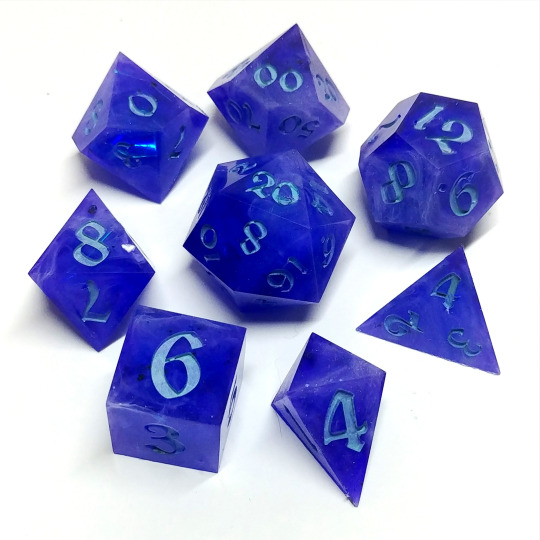
(same thing - when I think of potter, I think a dark blue).
charles: the last of the group to get into it. completely refused and repeated that 'he was far too smart for that kids' stuff' and everyone was wasting their time. but when someone had to dip out of the campaign last minute to deal with a medical thing, charles was brought in as filler with the promise of a day's R&R. at first I thought high elf, but switched to dragonborne, of the noble variety of course. chooses sorcerer (blessed with some innate magic, as his ego prefers). constantly complains about the needless complexity of the rules and why bother having ability scores when it's the modifier that counts???? is always arguing with the dm on his rolls. uses up half of his turns to use mage hand to steal hawkeye's things or cast ray of sickness on him when he's being annoying - but, when it comes down to it, is one of the more strategic players and has gotten them out of many sticky situations. like margaret, is pretending he isn't having fun, but isn't immune to jumping up with the others over a saving nat20 role, at one time even excitedly picking up a confused radar. in the end, swallows his pride to shyly ask if he can join the party finally ('you know, it'll, uh..it will give me something to do during those boring intervals, and clearly this group needs all the brains it can get..' '..charles, you wanna come play with us?' 'well, if I must..').
dice of choice:
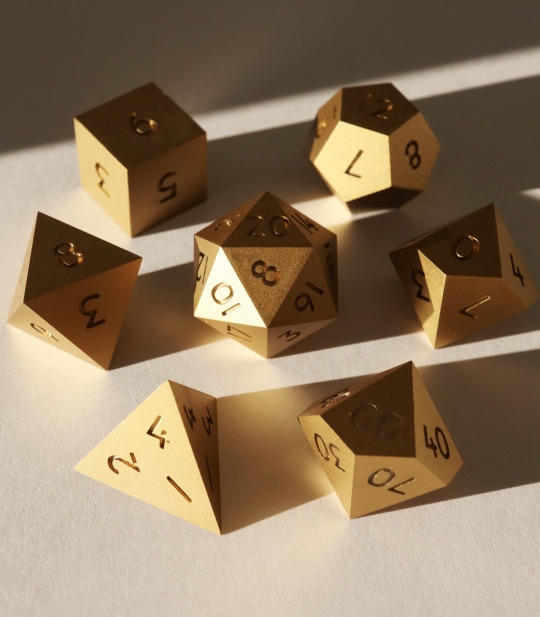
(the snootiest of dice, a pure gold colour).
mulcahy: also initially intimidated by the mechanics, but is happy to play a game with his friends. a possible half-elf or maybe a wise owlin. cleric, obviously. gets invested in the storyline, often applauding the dm's story or asking 'what happens next???" only to be told to wait till the next meet. one of the few who has actual healing spells and probably the only reason everyone didn't die in their first battle. a nerd who enjoys solving the puzzles. actually gets into the lore and one time had a deep, 2 hr conversation with radar & hawkeye about the disenfranchisement of some of the races and the hierarchy of the class/rule structure within the fantasy realm, and how it relates to theirs. the next day, radar came to his tent to show him a little sketch he did of his character in cleric robes, shrugging it off, but mulcahy loved it so much he pinned it up on his tent walls.
dice of choice:

(inspired by one of my favourite mulcahy lines, when he's talking about missing holding services in real churches - 'I am rather fond of stained glass', which I always think of whenever I see stained windows. tried to pick the ones that emulated the colours best (also would've liked maybe a light, forest green colour; it just feels mulcahy-esque to me).
klinger: one of the first to join bc what else what he gunna do but sit in his tent, sewing up pantyhose? rogue class, of course, relating to the 'urchin' background. changeling race, so that way with his class he can hide at any moment, and also, as he says, 'can perfectly match his outfit no matter what he looks like!' tries to follow the storyline but doesn't have the attention span for it, half the time guessing the wrong answer to any clue or puzzle (will come and poke the dm awake in the middle of the night with his patrol gun, claiming to have figured it out). second after hawkeye to try and Fuck his way out of a situation. cannot do math to save his life, making margaret often rip his dice away from him to add it herself. will gang up with hawkeye to use his pickpocket skill on charles. resourceful enough to have tricked the villains multiple times and gotten away with it but will also roll to try and kick the villain in the nuts to see what happens.
dice of choice:
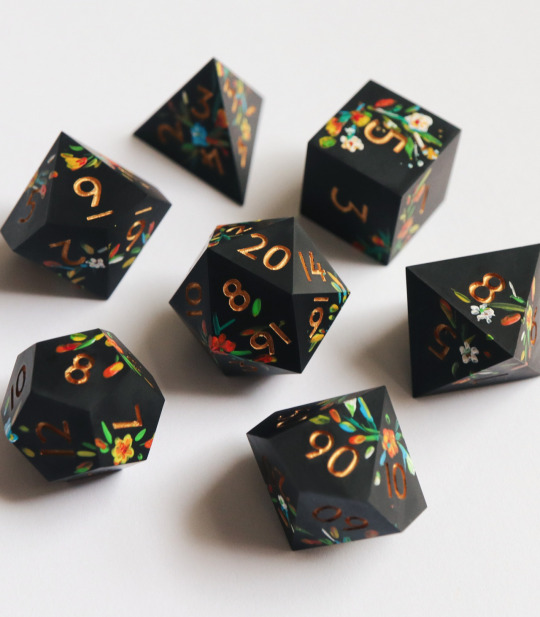
(these just screamed klinger to me; I like the dark, 'masculine' colour contrasted with with the colourful flowers).
bj: thought I missed him? well, I saved the best for last bc bj...is the dm! ha ha! no one really in particular stood out, but after thinking on it, he seems like the best fit. first, I was thinking of the episode 'the kids' where he gets really into the story he's telling, full of voices and sound affects and all. and secondly, our kindly mustacheo'd doctor loves Mind Games and pranks - what better way then stringing his friends along into one big, zigzag puzzle? bj loves nothing more then having his friends on the edge of their seats, only to pull out a bad guy the group thought they got rid of months ago, glee in his eyes watching them combust into screaming and table flipping. getting a thrill during off hours, hearing hawkeye & charles hastily whisper across bunks to each other on the campaign thinking he can't hear them, or getting shaken awake by margaret in the middle of the night, demanding answers. he spends hours planning out the campaigns in the tent (and finding new places to hide his papers from hawkeye), sometimes writing peg about it and occasionally - if the timing of the mail is right - using her suggestions she writes back. but mostly, bj just loves watching his friends have a good time - cheering each other on and hollering with each battle won, feeling proud of them for everything accomplished (when he doesn't have to babysit hawkeye & charles from casting spells on each other, trying to answer radar's 49th question on how rolls work, or keep margaret from solo fighting the demon fifteen levels above her).
dice of choice:

(idk, these just feel 'bj hunnicutt' to me).
other camp members:
- frank: was only let in Once after margaret begged hawk & bj, saying it was only fair. initially picked human bc 'they're clearly the purest and most civilized race!!' (causing eyerolls), quit thirty minutes in after being told he couldn't be a fighter 'cause they already had margaret and that he couldn't just 'set all his abilities to 20', calling them all nerds and angrily throwing a d20, only for it to bounce back on the tent beam and hit him in the eye.
- some of the nurses have occasionally filled in, but otherwise don't play outside of margaret (most of their time was filled up with hawkeye using his character to flirt with theirs). one time nurse kellye filled in; she played a cute little halfling druid, and her and radar teamed up to help rescue all the forest animals, much to the groups chagrin.
- zale & igor: permanently banned. both tried to eat the dice on a dare.
campaigns are held twice a month in the swamp, with drinks and stale pretzels to go around. use to sometimes go all night but after one too many nights of clambering arguments over each other's rolls, the whole camp banded together to force a curfew. while the game only exists within the swamp's quarters, they'll once and a while jokingly call each other by their character's names (and if you're margaret, one time accidentally using it to call hawkeye to surgery, which he now never lets you live down). during the last campaign of the story, radar pulls out another drawing he did - this time of everyone's characters, standing valiantly over the dragon they slayed. it now has a place of honour hung in the swamp.
#m*a*s*h#mash 4077#mash tv show#hawkeye pierce#bj hunnicutt#radar o'reilly#maxwell klinger#margaret houlihan#charles emerson winchester iii#sherman potter#henry blake#father mulcahy#does that cover everyone?#no reason adding frank don't think anyone is searching his tag#and yes I know I forgot trapper#sorry to all the trapper girlies out there but he was never my favourite and I didn't really know what to say about him#but if anyone has any you're welcome to add on!#even for characters I've already mentioned I'd love to hear about more Shenanigans (tm)#dnd headcanon#please know that I have a bare-surface understanding of dnd so if anything sounds wrong..that's why
34 notes
·
View notes
Text
William Blake and Good Omens - an intertextual analysis
Please note: I did another version of this and posted it, but it was quite hurried, way too short, and was incorrect in a number of ways so I deleted it. However it had already been reblogged by the time i did so. If you happen to see another version of this meta that's not the right one, this is the version I'm happy with!
After my previous post re William Blake and Good Omens did so well, and so many people showed an interest I've decided to do a more in depth piece. This is focused upon the TV version of Good Omens, not the book.
Please don't tag Neil in this - although it's mostly textual analysis I do a very small amount of S3 theorising, and I know he doesn't want to see that.
I am in no way suggesting that Neil and Terry specifically wrote Good Omens with Blake in mind, I honestly just wanted an excuse to write more about Blake because I love his work so much, and I thought it would be interesting to try and apply some intertexuality since the works will contain similar themes, both being about God, religion, humanity, and angels and demons.
I also should stress that I am not an expert on Blake, there are people far more qualified to comment on him than I. I'm just a former literature student who loves his work.
There have been many different interpretations of Blake's work over the years, so it's completely fine to disagree with someone else's ideas about it, as with any work of art or literature. And although this piece is likely to be long, I'll barely be able to scratch the surface of all the possible meanings that could be ascribed to it.
Much like the old adage that if someone claims to understand quantum physics they're lying, I'm not sure anyone can truly fathom the full meaning of Blake's philosophy (especially in his later prophetic works, fuuuuuuck those beasts....), so if you're confused by him don't be discouraged, that's perfectly normal!
That being said, I wish to discuss the parallels between Good Omens and The Marriage of Heaven and Hell, my personal favourite and probably the most accessible of his longer works.
"Without contraries is no progression. Attraction and Repulsion, Reason and Energy, Love and Hate, are necessary to Human existence.
From these contraries spring what the religious call Good & Evil. Good is the passive that obeys Reason. Evil is the active springing from Energy.
Good is Heaven. Evil is Hell."
This excerpt is from near the opening and sets out the central idea of the work - that there is an essential duality to humanity, and each person is a combination of extremes. These extremes are not at war with each other, but rather are equally necessary, hence the "marriage" of the title. "The Marriage of Heaven and Hell" is a metaphor for the human experience.
Consistently throughout The Marriage... Blake refers to the two extremes as Reason and Energy. These terms could be construed in a number of different ways: thought versus emotion, mental versus physical, restraint versus desire, temperance versus excess, caution versus impulsiveness, and following the rules versus free will.
Blake's use of the word "Reason" in this context may be somewhat confusing, however he likely chose it because of his negative feelings towards science and the Age of Enlightenment. Blake saw literal visions of angels and prophets and the divinity of all creation, and hated that science reduced everything to formulas, calculations, and materialism, leaving the world bereft of wonder. "Art is the Tree of Life. Science is the Tree of Death" as he put it.
His ideas about "reason" are best expressed by his painting "Newton". Though inspired by the scientist, it is not a portrait - instead it depicts a figure deeply engrossed in scientific drawings and calculations, totally ignoring the beauty all around him - see below.

In the context of The Marriage... Reason is "passive" because it involves thought, caution, self-restraint, and doing what you are told, all states which block action. Energy is "active" because it is physical, emotional, impulsive and allows you to act based on your own choices and desires. It's quite clear that Blake feels "energy" is the preferable state - he tells us as much in the next section:
"The Voice of the Devil
All Bibles or sacred codes, have been the causes of the following Errors.
1. That Man has two real existing principles Viz: a Body & a Soul.
2. That Energy, call'd Evil, is alone from the Body, & that Reason, call'd Good, is alone from the Soul.
3. That God will torment Man in Eternity for following his Energies.
But the following Contraries to these are True.
1. Man has no Body distinct from his Soul; for that call'd Body is a portion of Soul discern'd by the five Senses, the chief inlets of Soul in this age.
2. Energy is the only life and is from the Body and Reason is the bound or outward circumference of Energy.
3. Energy is Eternal Delight."
So the body is an aspect of the soul, not separate from it, Energy comes from the body, it is Reason which places limits upon Energy, but Energy is eternal delight. Physicality, desire, impulsiveness, emotion, sensual pleasure and free will are not wrong or evil, they are aspects of the human soul and it is from them that we derive our enjoyment of life.
This does not necessarily mean that Reason is always bad. After all, Blake tells us that both are necessary for human existence. Sometimes temperance, caution and thought before action are required. But Reason becomes negative when it "usurps its place and governs the unwilling", i.e. when it completely supplants Energy and becomes the sole guiding factor, forcing passivity.
The Angels of The Marriage... are governed by "systematic reasoning", therefore they are wholly creatures of Reason. They are also "all religious" meaning they believe the "errors" stated above. His Devils by contrast "hate religion" meaning they believe the "contraries", which are the true statements according to Blake. It does not necessarily follow that they are wholly governed by Energy, merely that they believe Energy is "eternal delight".
It is worth noting at this point that Blake saw God and religion as totally separate. For Blake, "God" is that connection with divine wonder which was integral to his life; he tells us plainly that "all deities reside in the human breast" and that "the voice of honest indignation is the voice of God". In other words all humans have a direct and intuitive link with God and don't require the church, Priests, or a religious framework and adherence to a set of rules in order to reach moral decisions. These rules exist only to "enslave the vulgar".
The importance of this ability to make one's own choices about a moral course of action is shown by one of the "Memorable Fancy" sections of The Marriage...
Blake relates how a Devil is able to use an Angel's "systematic reasoning" against them:
"if Jesus Christ is the greatest man, you ought to love him in the greatest degree; now hear how he has given his sanction to the law of ten commandments: did he not mock at the sabbath, and so mock the sabbaths God? Murder those who were murder'd because of him? Turn away the law from the woman taken in adultery? Steal the labor of others to support him? Bear false witness when he omitted making a defence before Pilate? Covet when he pray'd for his disciples, and when he bid them shake off the dust of their feet against such as refused to lodge them? I tell you, no virtue can exist without breaking these ten commandments; Jesus was all virtue, and acted from impulse, not from rules."
The Angel has no way to refute the "reasoning" that Jesus was governed by Energy and "impulse", i.e. his own morality, the "voice of righteous indignation", not reasoning and the rules laid down by Heaven. And because Jesus is the Messiah he must be virtuous, therefore Energy is virtuous. The Angel immediately allows himself to be consumed by fire and is resurrected as a Devil.
How can these concepts apply to the world of Good Omens? This was where my first draft was totally incorrect, as I tried to transfer Blake's ideas about Angels and Demons and Heaven and Hell wholesale, applying "reason" to Aziraphale and Heaven and "energy" to Crowley and Hell. In fact the divide is slightly different in the GO-verse: Crowley and Aziraphale *both* represent Energy, and it is Heaven and Hell that act according to Reason.
At first glance Aziraphale may appear to toe the line - he needs creative application of the rules to make him comfortable with trying to avert the apocalypse, and when he doesn't like the way matters are being handled by the Archangels he seeks a higher authority and goes straight to God. He'd clearly prefer someone to be confirming the rightness of his actions for him. However this doesn't mean that he won't act on his own.
Immediately upon his introduction to the story he has given away his flaming sword, an action that he took impulsively because he felt it was right, not because someone told him to. It bothers him, but he does it anyway.
In the Job storyline, though he initially looks for some loophole within the rules that will allow him to save Job's children, in the end he directly goes against Heaven to do it, even though he believes he is going to Fall and become a Demon for having done so.
Though he resists it and exhausts all other possible avenues first, he eventually does take an active role in averting the apocalypse in S1.
He hides Jim at great personal risk to himself and against the will of both Heaven and Hell, again because he feels it is the right thing to do.
He is therefore perfectly capable of independent action from a position of "righteous indignation".
On a more basic level, he enjoys worldly pleasures, which all come from "energy" according to Blake's philosophy. Food and drink most obviously, but also books, music, dancing, theatre, art and so on.
Crowley is more easy to place as acting from Energy - in spite of the obvious aesthetic differences between them, he also loves worldly pleasures. Alcohol and coffee, snazzy clothing, driving his car with Queen blaring on the stereo, going to lunch with Aziraphale, Shakespearean comedies. All things he isn't supposed to want or need, and which baffle other Demons, in the same way that Aziraphale's desire for food baffles the Angels.
And he's absolutely willing to act according to his own moral impulses when they conflict with Hell's orders (or Heaven's), be it saving Job's children, ensuring that Elspeth doesn't die by suicide, or averting the apocalypse. Yes, he'll try to hide his "good" actions in order to avoid punishment by Hell, but he's firmly "on his own side".
Conversely, Heaven and Hell are both part of the structure of religion in this story, are strictly adherent to a set of rules, and their inhabitants appear to have no real desires of their own, other than possible advancement within the systems they uphold. They are "passive" in that their functions allow the status quo to continue and the "great plan" to unfold as they believe it is meant to, even though each side expects a different outcome.
Again, applying Blake's philosophy, I would say the reason for this is that "energy is from the body". Crowley and Aziraphale have both been given bodies in order that they can exist on earth, and *have* existed on earth for 6000 years, therefore "energy" - physical pleasures and free thinking - have become a part of who they are.
On a more fundamental level, possession of a body can be equated to humanity, and humanity has been shown as the most powerful force of all in this story, its influence having led to Adam becoming "human incarnate", and thus acting according to what he feels is right, instead of fulfilling the function he was destined for.
Heaven and Hell contain no material objects, and the Angels and Demons are spiritual beings, having no bodies, so they are not open to energy, and therefore are wholly governed by Reason, and the preservation of the religious structures within which they exist. Structures which, as for Blake, may not actually have anything to do with God herself. In S1 she is a distant observer, clearly aware through her narration of all that is going on, but not interceding in any way. In S2 she is barely present save for her voice being heard briefly in Job, and overlaid with Gabriel's on two occasions.
Bearing all this in mind, what predictions can we make regarding S3 by applying Blake's philosophy?
"The ancient tradition that the world will be consumed in fire at the end of six thousand years is true, as I have heard from Hell.
For the cherub with his flaming sword is hereby commanded to leave his guard at [the] tree of life, and when he does, the whole creation will be consumed and appear infinite and holy, whereas it now appears finite and corrupt.
This will come to pass by an improvement of sensual enjoyment."
The parallels of the cherub with his flaming sword, and the passage of 6000 years should be obvious to anyone reading this - they have of course been lifted directly from the Bible as they are in GO.
I have read some metas which speculated that Aziraphale's bookshop, or perhaps Earth itself, is a metaphorical stand-in for Eden or The Tree of Life. Aziraphale has been commanded to leave his "Eden" and will now be instrumental in causing the whole of creation to become infinite and holy, but Blake tells us this will be done by an improvement of sensual enjoyment, which arises from Energy not Reason.
Sensual enjoyment is something which is intrinsic to Aziraphale's character, and this could make his placement in Heaven very important.
Putting aside all the "final fifteen" theories and taking matters at face value, Aziraphale tells us that if he's in charge he can make a difference - he needs to subvert the system from the inside out. The most subversive thing of all could be that a sensualist who acts according to "the voice of moral indignation" and "Energy" has become the supreme Archangel. We have seen in Blake how a realisation that Energy could be virtuous was enough to convert an Angel into a Devil (incidentally, does the image of an Angel being consumed by fire and emerging as a Devil seem familiar at all...)
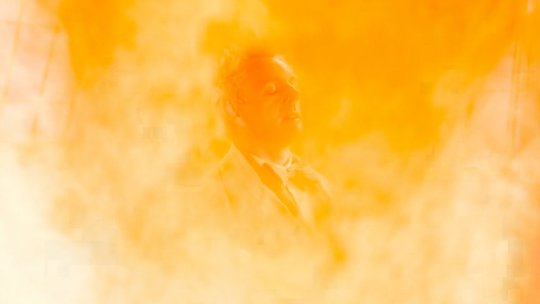
We may have seen the beginnings of this already. Gabriel and Beelzebub became open to Energy from such little things as visiting earth, spending time in one another's company, and their mutual enjoyment of a song, which has given them wants and desires beyond those dictated by Heaven and Hell. This is enough to make them wish to leave their roles behind.
It's possible that the same may happen with Muriel. They haven't yet imbibed food or drink, but they have shown an enjoyment of books, which are an earthly pleasure, and open the reader up to new ideas and ways of thinking.
Of course, this would lead to questions regarding the Metatron's statement that he has "ingested things", and whether this means he is acting from reason or energy. Of course the simplest explanation is that it is a manipulation tactic, and he is lying about having done so, but if true that statement has some interesting implications. However, this is now super-long and I'm out of juice, so will leave others to speculate. I may return to this in the future!
There we go, hope you enjoyed. I doubt this will reach nearly as many people as my first Blake post, but if a few find it of interest then my work is done!
#good omens#good omens 2#go2#crowley#aziraphale#good omens tv#good omens meta#good omens s2#good omens season 3#good omens s3#good omens brainrot#william blake#the marriage of heaven and hell#poetry#poems and poetry#books and reading#english literature#Textual analysis#intertextuality#good omens theories#good omens thoughts
44 notes
·
View notes
Text
THE MORNING AFTER: ONLY FRIENDS, EPISODE 5 ("CH-CH-CH-CHANGES / TURN AND FACE THE STRANGE") EDITION
Well, well, FUCKING well. Man, I am REELING. THAT. Was a HELL of an episode of a drama. Jojo and his team need to applaud themselves.
Let me set this up by sharing with y’all a tweet that really stuck with me after episode 4, but I think it’s pertinent to episode 5:
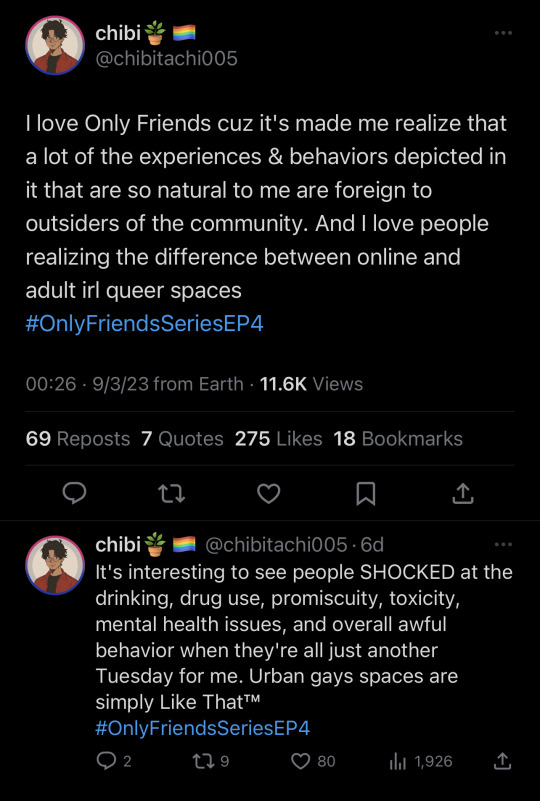
Now, yes -- this is a touch of a generalization (many of my queer friends are straight-edge-and-or-early-to-bed-while-living-in-cities folx), but I want to note something important in this tweet.
Before I got started on episode 5 last night, after having seen a lot of the meta and reactions on my dash throughout the day, I shot a note to dear @ranchthoughts that I thought I'd have to get a little #oldmom on this episode. Speaking to chibi's note above: toxicity happens to be a common human trait. Seeing that there was QUITE a bit of surprise for Boston's "outing" of Ray to Sand on my dash actually surprised me.
From my lawyer friends, I learned about the following concept, and I just cracked the fuck up the first time I heard it, because it rang really true once I got my head around it: a lawyer friend once told me that when he started out at a typical major American law firm, his orientation included hearing a presentation from an older managing partner about the idea of the "equal opportunity asshole." Meaning: there's workplace harassment against protected classes, like race-based or sex-based harassment. But: can you get sued if you treat EVERYONE AROUND YOU like shit? And, he didn't mean on a personal level, not on an attacking level. Just on an abrupt, aggressive level. A bossy level. A very direct-toned level.
That kind of interaction -- an interaction with an equal opportunity asshole -- we know those kinds of people, right? These kinds of folks are...titchy. They might jump to conclusions. They're rooted in their worldview ONE HUNDRED PERCENT. They lack empathy. They make you feel unsettled. They are emotionally disconnected from you. They have NO interest in being emotionally connected WITH YOU.
When I dove into episode 5, I really thought I'd be writing about Boston as the equal opportunity asshole, and I think that this theory still holds to a great extent, but -- there's a but, a slight and fascinating-to-me but, that I'll get to in a second.
@ranchthoughts did the thing once more of covering EVERYTHING in her episode 5 ephemerality breakdown, so dear Ranch, I'm just gonna repeat some stuff you said in my own words, if you don't mind. First off, a couple of gushes:
1) That blind dining scene had me swooning. "Life is like a box of chocolates: you never know what you're gonna get," was what I was hearing when I was watching that. These lovely idiots are blind to what's happening in front of them, and what that means to them -- BUT THAT'S OKAY, BECAUSE THEY ARE YOUNG. YOUNG AND INEXPERIENCED. The blind dining metaphor, oh gawd -- using your senses to come to realizations about how you're truly feeling, and how to connect better with WHAT you're feeling? Slamming my hands on the table! BRILLIANT. Mew is SO clueless (OR IS HE?!?!??!).
1.5) And -- remember (all you young folks out there!). Youth is fleeting (cc the Ephemerality Squad). What we're watching of this cohort of "friends" is their building their bases of life experiences NOW, that will TEACH them how they will live more EXPERIENCED lives in their futures. Will their lives be better? Who the fuck knows. But their FUTURE LIVES will be shaped by what they're experiencing NOW.
2) Ranch nailed this already, but Sand is just as bad as Ray in living in the annals of time. (He's also naughty for another reason, which I'll get into in a postscript.) He's got the vintage tees, he wants to rewind to Woodstock, he's a fan of mostly classic Brit rock (....I will not call the Arctic Monkeys classic Brit rock, I will not, thus, "mostly," lol.) Dear friend @neuroticbookworm described this phenomenon of Sand's in the frame of Ray dabbling in a day of poverty tourism, as essentially what his day and night with Sand constituted. But I'd also add that Sand's living in a fantasy world of a couple levels to break the monotony of his everyday life. Those flashes of hope that he'll travel to world to festivals one day -- as he clocks 450 baht (around $12 USD) per bottle, as he sings, as he gets up and gets down -- yes, Ray is his fantasy, his non-existent 25th hour, Ray is the break from monotony that Sand needs as a thing to look forward too. Of course it comes crashing down.
3) But it'll come crashing down anyway, because I will posit the following: Sand's survival fantasies are necessary to keep him going by way of motivation, because Sand is going to be held back by others, and not just Ray. Sand is caught in a trap of filial piety. (OH SHIT! GIMME!) He's paying off his mom's debts.
We don't know how much the debts are. [We're seeing in Dangerous Romance that Sailom is getting his ass beat if he and his brother don't pay the debt collectors on time every month. Shit, the debt collectors are even trying to make Sailom an escort (which then turns into Kanghan buying off Sailom himself, but lemme leave that alone, WRONG SHOW)]. But even Sand's mom admits: Sand is solving a problem of MY OWN CREATION. How good is my son? He's a very good son. Drink up, honey.
Sand thought of Ray: wow, this guy might be into me, and shit, I'm into him. And I could use this right now! I could use this break. And that illusion came crashing down when Sand -- an intelligent dude! -- put two and two together real fast. And Sand, very rightly -- because he is FAST learning independence, in a totally different way than the main OF quartet -- pulls the hell away, and puts away the fantasy of Ray at Alone O'Clock.
3.5) I just want to note, real quick, that we now have TWO of my favorite-ist themes in this show: we have intergenerational trauma by way of Ray, and filial piety by way of Sand. THANK YOU, JOJO AND TEAM! *This* bitch is TRACKIN'.
4) Big ephemerality note here: I just, I SWOONED, GOD, I LOVED IT, WHEN RAY REVEALED HIS MOTHER WAS AN ACTRESS. And that she was bitter about getting pregnant and how that affected her career. Are you kidding me? JOJO. NINEW. ALL OF YOU. BRILLIANT. The ephemerality OF SHOWBIZ ITSELF.
Aren't all these actors risking their damn careers by potentially BLOWING UP THEIR SHIPS for the sake of this show? (I mean, that's actually a little far-fetched, as FirstKhao will be the first GMMTV pair to have an intercontinental fanmeet, BUT STILL.) God, the commentary on the FICKLENESS of showbiz was just CHEF'S KISS.
5) As Ranch noted, this was the episode where CHANNNNNGGGGEEEEE was the big bell ringing. Top needed something different than his sexual monotony -- so he goes after Mew, and shit, homes is bored AF. (@lurkingshan covered this perfectly here.) Mew contemplates changing for Top, the LASIK, the sex, all of it. Top seems to try a different kind of sex with Mew -- soft and romantic sex that ends with "I love you." Nick (oh, my bubby Nick), changes for Boston, becomes ripped, finds buttons and slacks. Boston contemplates whittling his list down. Ray wears secondhand (lol, it's called "vintage," asshole). Sand changes his routine to accommodate Ray.
And yet. I very, very often say in my posts that the process of behavioral change is INCREDIBLY difficult.
The five stages of behavioral change are: pre-contemplation, contemplation (Nick and the podcast), preparation, action (Nick at the gym), and maintenance.
The risk to this process, at any point in time, is: RELAPSE.
Think of how difficult it is to quit smoking. To go on a diet. To start an exercise routine. To stop biting your nails.
What is the thing that marks these processes more than anything else?
It's the RELAPSE into the old behavior, the old habits.
We really saw Boston trying to change...something. Trying to stick out...something with Nick. Trying on something new. Kinda like the way Ray tried on his secondhand shirt.
And then Boston experiences a familiar trigger: a trigger of jealousy when Mew calls him, innocently, to give Boston the heads-up that he's about ready to experience some cherry magic.
And that trigger, like all of our own triggers -- stress, a change of environment, a change of the people around you -- sent Boston back to a place.
Listen, I will, in no way, ever defend Boston's behavior. He was drunk and high AF, and he's generally toxic. Jojo is totally egging this on.
I would absolutely call Boston an equal opportunity asshole. He's only seeing the world from his own worldview, his own desires, his own desire to control whatever he can control around him.
But like I said before: toxicity is FAR more common that we'd like to believe. And toxicity within someone doesn't disappear very easily -- just like any of our habits, be they good or bad habits.
Boston was trying out a new life, for a few minutes (lol), of being a LITTLE LESS EPHEMERAL, a little less aloof -- a little less toxic. And a trigger brought him back to his bad place, and I think what we saw in that damn outburst was a relapse of the highest order.
Ray repeats to Nick what Top and Cheum have already said. This guy, Boston? He's nasty. Stay away. Boston's an asshole. Boston's still being stigmatized, and still living up to his label.
How would I summarize all of this? Throughout this ENTIRE episode, what was screaming within my head, as I said above, was: youth is fleeting. Youth itself is ephemeral. The experiences these young folks are going through at this moment in this show will build their experiences for how they will survive (or not) in their futures.
We may think that Boston, and Ray, and Mew, will not learn from their dumbass behavior, but -- they will. They will have no choice. Because their time being this young, and inexperienced, and idiotic, will flee. They'll graduate, and they will have to learn how to survive in a "real" world that may very well be far more brutal to them than their proximate friendships are to them right now. And man, if they have to experience lives that are MORE brutal than these proximate friendships they have, then good LUCK to them, because, well -- shit. It ain't pretty the way it is right now.
...
P.S. I just thought this whole scene was brilliant. Sand, honey, you're not as innocent as your meow feelings are letting on. I'm holding you accountable for what you're saying to Ray, too.



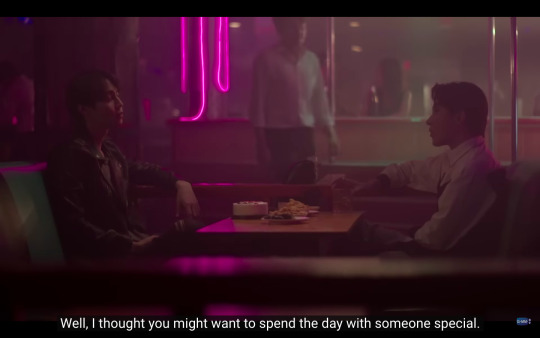
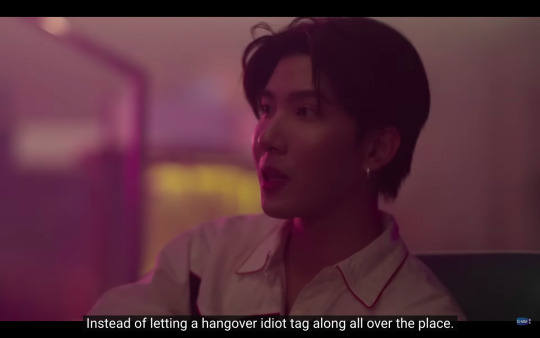

P.P.S. JENNIE.
(HAPPY SUNDAY, EPHEMERALITY SQUAD! @ranchthoughts @lurkingshan @neuroticbookworm @distant-screaming @slayerkitty @clara-maybe-ontheroad @twig-tea)
(HEY, SQUAD: if you tag me in things, and I forget to reblog, send me a DM! I'm on the last stages of this moving chapter of my life, and I don't wanna miss your meta!)
#only friends#only friends meta#only friends the series#only friends the series meta#firstkhao#first kanaphan#khaotung thanawat#sand x ray#ray x sand#forcebook#force jiratchapong#book kasidet#mew x top#top x mew#neomark#neo trai#mark pakin#nick x boston#boston x nick#jennie panhan#tee teeradej#i need more tee teeradej y'all#he fine#only friends the morning after
128 notes
·
View notes
Text
Good Omens, or the Disruption of Gay = Death
CW: historical homophobic violence and death
@queerfables recently wrote an excellent meta on slash fiction and the concept of "Taking Away the Glass". I had some thoughts, which I was going to add as a reblog, but this seems to spiraled away from the original post, so I'm posting this on its own, but I'm referencing their ideas and references, so maybe go read that first.
This is especially for those of you who are, say, under 25 (which is apparently most of Tumblr), and who haven't had much opportunity to learn queer history. Let me say, I'm not a queer historian. I am a queer who has lived through recent history and can reasonably clearly remember the last at least 35 years of it, and I was fortunate to have had schooling that did include some earlier queer history and didn't shy away from queer topics. (I recognize now what a revolutionary bit of teaching that was.)
I also want to acknowledge that I'm writing from a place of relative privilege, as a white cis woman living in a progressive part of North America, and that some of what is history for me is still life for others. I am speaking from my own personal experiences here -they are by no means universal. But I think it's important for us to share our stories, so this is part of mine.
When You're Dying in America, at the End of the Millenium
Fables quotes a video by thingswithwings as saying "Homosexuality, or just loving touch between two people of the same gender, is equivalent to death in this media narrative." In the 1980s and 1990s, when Good Omens was written and first published, that wasn't a metaphor. When I was a baby proto-queer, what I heard about being gay was that it killed you.
My formative memories of what it meant to be gay weren't pride parades or even riots. It was gay men dying by the thousands and governments and religious leaders ignoring them at best, and welcoming their deaths at worst. To be gay, and a gay man in particular, was to be marked for death. It wasn't until a straight white boy who got it from a blood transfusion died that AIDS became something that "normal" people had any empathy for and governments really started to act.
The gay representation I rember in the media as a moderately sheltered child from the 80s and 90s with left-of-center middle class white parents was news about AIDS, Philadelphia (death from AIDS), Ellen (cancelled after she came out), and eventually RENT (desperately trying not to die of AIDS or capitalism). I knew a very small handful of out gay adults, and no trans adults at all.
My first time being in a large group of queer people was a vigil for Matthew Sheppard, who had been beaten and left to die tied to a fence. I remember being terrified. I wasn't out yet. I knew people who hated us might be there, this group of mostly young queer people gathering with candles to cry over a boy we'd never met, and over the many others who had died just for being what we were. I'd never even kissed a girl yet. I only knew my queerness in relation to death.
In the last decade or so of the 20th century, being queer was about grasping any bit of joy you could from a world that very clearly would prefer you were dead. It was defiance and anger and fear every time you held your love's hand, or kissed them in public. My second date with the person who would become my spouse was interrupted by some dude in a truck shouting slurs at us was we walked down a quiet street. We laughed it off - no one had thrown anything, or beaten us, so it wasn't a big deal. It should have been a big deal, but we couldn't let it be. When you're marked for misery and death, you can't let the little things get to you. You just hold each other's hands as tightly as you can and defiantly keep walking.
An Angel and a Demon and Immortality
Good Omens was written during some of the darkest days of the AIDS epidemic (which is still ongoing, by the way), before there were effective treatments, when gay = death. It is a mainstream, mass-market book. It wouldn't be shelved in the "Gay and Lesbian" section at the book store, it would be shelved with humour, or possibly fantasy.
And yet, here we have these two beings. An angel and a demon, with an unlikely friendship, and who are very clearly written as gay. Or, at least, as percieved as gay by outside observers. Aziraphale in particular is (in one of my favorite lines) "gayer than a tree full of monkeys on nitrous oxide," and "THE southern pansy" (self-proclaimed). Together, they are "consenting bicycle repairmen" (Neil Gaiman's explanation for context) who Anathema was safe with the whole time.
Whether you caught the subtextual shippyness of their relationship (and to be honest, I only did a little when I first read it), they were very obviously written as precieved-gay characters, in a story where their precieved gay-ness wasn't the cause of their downfall. Yes, an 11 year old calls Aziraphale a faggot. But he doesn't get arrested or beaten of killed - he just gets covered in cake. And he loves cake! The attempted insult just rolls off him like water off a duck's back, because he has no pressure not to be visibly gay.
Becuase, see, unlike us humans, unlike his gay contemporaries, he is not marked for death. He's an angel. He's immortal. Even more, he was made by God, exactly how God wanted, presumably, and that is intelligent, English, and so very gay.
Niel and Terry are saying so much here. You can be gay and loved. You can be gay and have a deep relationship. You can be gay because that's how God made you. You can be gay forever, through all time, with someone beside you, finding joy in your life.
You can be gay and not die. You can be gay and live.
#good omens meta#queer history#aids history#this one's personal#neil gaiman#terry pratchett#death#hiv/aids#homophobia
63 notes
·
View notes